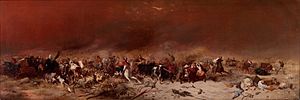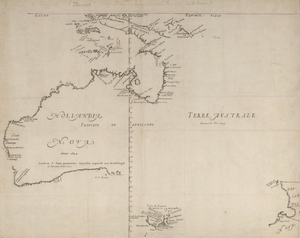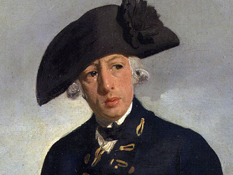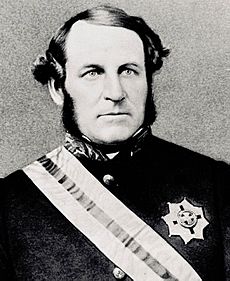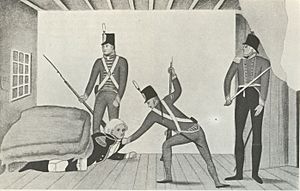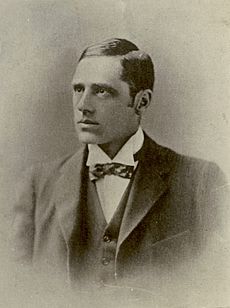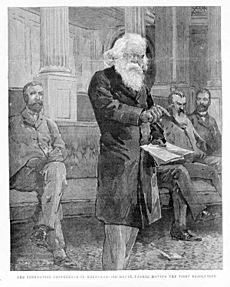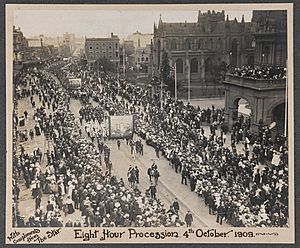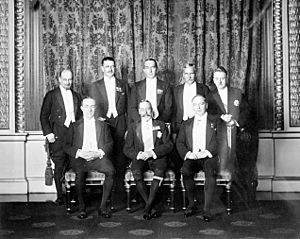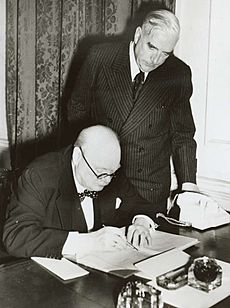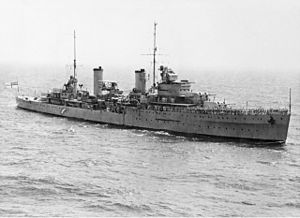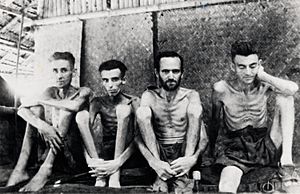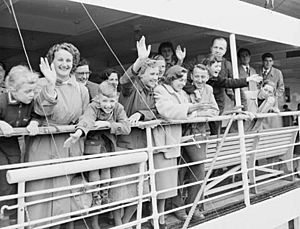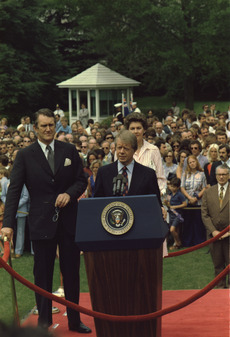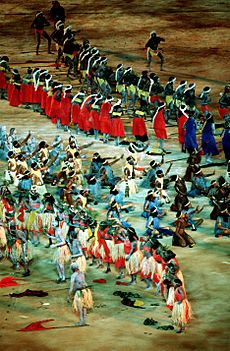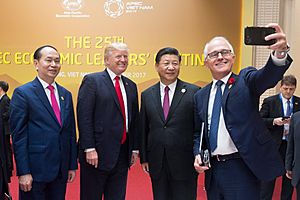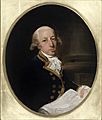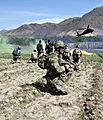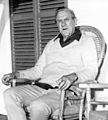History of Australia facts for kids
The history of Australia is the story of the land and peoples of the continent of Australia.
People first arrived on the Australian mainland by sea from Maritime Southeast Asia between 50,000 and 65,000 years ago, and penetrated to all parts of the continent, from the rainforests in the north, the deserts of the centre, and the sub-Antarctic islands of Tasmania and Bass Strait. The artistic, musical and spiritual traditions they established are among the longest surviving such traditions in human history.
The first Torres Strait Islanders - ethnically and culturally distinct from the Aboriginal people - arrived from what is now Papua New Guinea around 2,500 years ago, and settled in the islands of the Torres Strait and the Cape York Peninsula forming the northern tip of the Australian landmass.
The first known landing in Australia by Europeans was in 1606 by Dutch navigator Willem Janszoon. Later that year, Spanish explorer Luís Vaz de Torres sailed through, and navigated, what is now called Torres Strait and associated islands. Twenty-nine other Dutch navigators explored the western and southern coasts in the 17th century and named the continent New Holland. Macassan trepangers visited Australia's northern coasts after 1720, possibly earlier. Other European explorers followed until, in 1770, Lieutenant James Cook charted the east coast of Australia for Great Britain. He returned to London with accounts favouring colonisation at Botany Bay (now in Sydney).
The First Fleet of British ships arrived at Botany Bay in January 1788 to establish a penal colony, the first colony on the Australian mainland. In the century that followed, the British established other colonies on the continent, and European explorers ventured into its interior. Aboriginal people were greatly weakened and their numbers diminished by introduced diseases and conflict with the colonists during this period.
Gold rushes and agricultural industries brought prosperity. Autonomous parliamentary democracies began to be established throughout the six British colonies from the mid-19th century. The colonies voted by referendum to unite in a federation in 1901, and modern Australia came into being. Australia fought on the side of Britain in the two world wars and became a long-standing ally of the United States when threatened by Imperial Japan during World War II. Trade with Asia increased and a post-war immigration program received more than 6.5 million migrants from every continent. Supported by immigration of people from almost every country in the world since the end of World War II, the population increased to more than 25.5 million by 2020, with 30 per cent of the population born overseas.
Contents
Aboriginal Australia
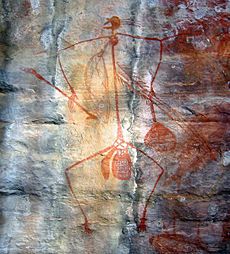
Early Indigenous history
The ancestors of Indigenous Australians are believed to have arrived in Australia 40,000 to 60,000 years ago, and possibly as early as 70,000 years ago. They developed a hunter-gatherer lifestyle, established enduring spiritual and artistic traditions and used stone technologies. At the time of first European contact, it has been estimated the existing population was at least 350,000, while recent archaeological finds suggest that a population of 750,000 could have been sustained.
There is considerable archaeological discussion as to the route taken by the first colonisers. People appear to have arrived by sea during a period of glaciation, when New Guinea and Tasmania were joined to the continent. The journey still required sea travel however, making them amongst the world's earlier mariners. Scott Cane wrote in 2013 that the first wave may have been prompted by the eruption of Mount Toba and if they arrived around 70,000 years ago could have crossed the water from Timor, when the sea level was low – but if they came later, around 50,000 years ago, a more likely route would be through the Moluccas to New Guinea. Given that the likely landfall regions have been under around 50 metres of water for the last 15,000 years, it is unlikely that the timing will ever be established with certainty.
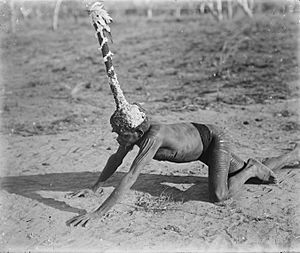
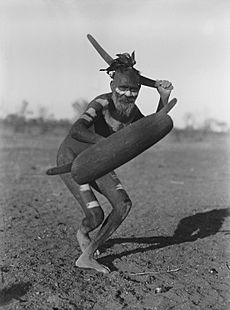
The earliest known human remains were found at Lake Mungo, a dry lake in the southwest of New South Wales. Remains found at Mungo suggest one of the world's oldest known cremations, thus indicating early evidence for religious ritual among humans. According to Australian Aboriginal mythology and the animist framework developed in Aboriginal Australia, the Dreaming is a sacred era in which ancestral totemic spirit beings formed The Creation. The Dreaming established the laws and structures of society and the ceremonies performed to ensure continuity of life and land. It remains a prominent feature of Australian Aboriginal art. Aboriginal art is believed to be the oldest continuing tradition of art in the world. Evidence of Aboriginal art can be traced back at least 30,000 years and is found throughout Australia (notably at Uluru and Kakadu National Park in the Northern Territory). In terms of age and abundance, cave art in Australia is comparable to that of Lascaux and Altamira in Europe.
Manning Clark wrote that the ancestors of the Aboriginal Australians were slow to reach Tasmania, probably owing to an ice barrier existing across the South East of the continent. The Aboriginal Australians, he noted, did not develop agriculture, probably owing to a lack of seed bearing plants and animals suitable for domestication. Thus, the population remained low. Clark considered that the three potential pre-European colonising powers and traders of East Asia—the Hindu-Buddhists of southern India, the Muslims of Northern India and the Chinese—each petered out in their southward advance and did not attempt a settlement across the straits separating Indonesia from Australia. But trepang fisherman did reach the north coast, which they called "Marege" or "land of the trepang". For centuries, Makassan trade flourished with Aboriginal Australians on Australia's north coast, particularly with the Yolngu people of northeast Arnhem Land.
The greatest population density for Aboriginal Australians developed in the southern and eastern regions, the River Murray valley in particular. Aboriginal Australians lived and used resources on the continent sustainably, agreeing to cease hunting and gathering at particular times to give populations and resources the chance to replenish. The arrival of Australia's first people nevertheless affected the continent significantly, and, along with climate change, may have contributed to the extinction of Australia's megafauna. The practice of firestick farming amongst northern Aboriginal Australians to increase the abundance of plants that attracted animals, transformed dry rainforest into savanna. The introduction of the dingo by Aboriginal people around 3,000–4,000 years ago may, along with human hunting, have contributed to the extinction of the thylacine, Tasmanian devil, and Tasmanian native-hen from mainland Australia.
One genetic study in 2012 by Irina Pugach and colleagues at the Max Planck Institute for Evolutionary Anthropology has suggested that about 4,000 years before the First Fleet landed, some Indian explorers settled in Australia and assimilated into the local population in roughly 2217 BC.
Despite considerable cultural continuity, life was not without significant changes. Some 10–12,000 years ago, Tasmania became isolated from the mainland, and some stone technologies failed to reach the Tasmanian people (such as the hafting of stone tools and the use of the Boomerang). The land was not always kind; Aboriginal people of southeastern Australia endured "more than a dozen volcanic eruptions...(including) Mount Gambier, a mere 1,400 years ago." In southeastern Australia, near present-day Lake Condah, semi-permanent villages of beehive shaped shelters of stone developed, near bountiful food supplies.
The early wave of European observers like William Dampier described the hunter-gatherer lifestyle of the Aboriginal Australians of the West Coast as arduous and "miserable". Lieutenant James Cook on the other hand, speculated in his journal that the "Natives of New Holland" (the East Coast Aboriginal Australians whom he encountered) might in fact be far happier than Europeans. Watkin Tench, of the First Fleet, wrote of an admiration for the Aboriginal Australians of Botany Bay (Sydney) as good-natured and good-humoured people, though he also reported violent hostility between the Eora and Cammeraygal peoples, and noted violent domestic altercations between his friend Bennelong and his wife Barangaroo. Settlers of the 19th century like Edward Curr observed that Aboriginal Australians "suffered less and enjoyed life more than the majority of civilized men." Historian Geoffrey Blainey wrote that the material standard of living for Aboriginal Australians was generally high, higher than that of many Europeans living at the time of the Dutch discovery of Australia.
By 1788, the population existed as 250 individual nations, many of which were in alliance with one another, and within each nation there existed several clans, from as few as five or six to as many as 30 or 40. Each nation had its own language and a few had multiple, thus over 250 languages existed, around 200 of which are now extinct. "Intricate kinship rules ordered the social relations of the people and diplomatic messengers and meeting rituals smoothed relations between groups", keeping group fighting, sorcery and domestic disputes to a minimum.
Permanent European settlers arrived at Sydney in 1788 and came to control most of the continent by end of the 19th century. Bastions of largely unaltered Aboriginal societies survived, particularly in Northern and Western Australia into the 20th century, until finally, a group of Pintupi people of the Gibson Desert became the last people to be contacted by outsider ways in 1984. While much knowledge was lost, Aboriginal art, music and culture, often scorned by Europeans during the initial phases of contact, survived and in time came to be celebrated by the wider Australian community.
Impact of European settlement
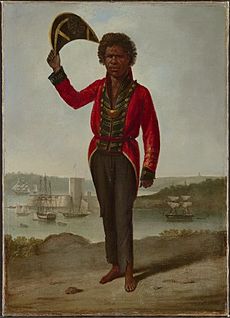
The first known landing in Australia by Europeans was by Dutch navigator Willem Janszoon in 1606. Twenty-nine other Dutch navigators explored the western and southern coasts in the 17th century, and dubbed the continent New Holland. Macassan trepangers visited Australia's northern coasts after 1720, possibly earlier. Other European explorers followed until navigator Lieutenant James Cook claimed the east coast of Australia for Britain in 1770, without conducting negotiations with the existing inhabitants. He returned with accounts favouring colonisation at Botany Bay (now in Sydney), New South Wales.
The first governor, Arthur Phillip, was instructed explicitly to establish friendship and good relations with the Aboriginal Australians and interactions between the early newcomers and the ancient landowners varied considerably throughout the colonial period—from the curiosity displayed by the early interlocutors Bennelong and Bungaree of Sydney, to the outright hostility of Pemulwuy and Windradyne of the Sydney region, and Yagan around Perth. Bennelong and a companion became the first Australians to sail to Europe, where they met King George III. Bungaree accompanied the explorer Matthew Flinders on the first circumnavigation of Australia. Pemulwuy was accused of the first killing of a white settler in 1790, and Windradyne resisted early British expansion beyond the Blue Mountains.
Conflict and disease
According to the historian Geoffrey Blainey, in Australia during the colonial period: "In a thousand isolated places there were occasional shootings and spearings. Even worse, smallpox, measles, influenza and other new diseases swept from one Aboriginal camp to another ... The main conqueror of Aboriginal Australians was to be disease and its ally, demoralisation".
Conflict in the Hawkesbury Nepean river district near the settlement at Sydney continued from 1795–1816.
Even before the arrival of European settlers in local districts beyond coastal New South Wales, Eurasian disease often preceded them. A smallpox epidemic was recorded near Sydney in 1789, which wiped out about half the Aboriginal Australians around Sydney. Opinion is divided as to the source of the smallpox. Some researchers argue that the smallpox was acquired through contact with Indonesian fishermen in the far north and then spread across the continent, reaching the Sydney area in 1789. Other research by Craig Mear, Michael Bennett, and Christopher Warren argues that, despite controversy, it is highly likely that the 1789 outbreak of smallpox was a deliberate act by British marines when they ran out of ammunition and needed to expand the settlement out to Parramatta. Smallpox then spread well beyond the then limits of European settlement, including much of southeastern Australia, reappearing in 1829–30, killing 40–60 percent of the Aboriginal population.
The impact of Europeans was profoundly disruptive to Aboriginal life and, though the extent of violence is debated, there was considerable conflict on the frontier. At the same time, some settlers were quite aware they were usurping the Aboriginal Australians place in Australia. In 1845, settler Charles Griffiths sought to justify this, writing; "The question comes to this; which has the better right—the savage, born in a country, which he runs over but can scarcely be said to occupy ... or the civilized man, who comes to introduce into this ... unproductive country, the industry which supports life."
From the 1960s, Australian writers began to re-assess European assumptions about Aboriginal Australia—with works including Alan Moorehead's The Fatal Impact (1966) and Geoffrey Blainey's landmark history Triumph of the Nomads (1975). In 1968, anthropologist W.E.H. Stanner described the lack of historical accounts of relations between Europeans and Aboriginal Australians as "the great Australian silence." Historian Henry Reynolds argues that there was a "historical neglect" of the Aboriginal Australians by historians until the late 1960s. Early commentaries often tended to describe Aboriginal Australians as doomed to extinction following the arrival of Europeans. William Westgarth's 1864 book on the colony of Victoria observed; "the case of the Aboriginal Australians of Victoria confirms ...it would seem almost an immutable law of nature that such inferior dark races should disappear." However, by the early 1970s historians like Lyndall Ryan, Henry Reynolds and Raymond Evans were trying to document and estimate the conflict and human toll on the frontier.

Many events illustrate violence and resistance as Aboriginal Australians sought to protect their lands from invasion and as settlers and pastoralists attempted to establish their presence. In May 1804, at Risdon Cove, Van Diemen's Land, perhaps 60 Aboriginal Australians were killed when they approached the town. The British established a new outpost in Van Diemen's Land (Tasmania) in 1803. Although Tasmanian history is amongst the most contested by modern historians, conflict between colonists and Aboriginal Australians was referred to in some contemporary accounts as the Black War. The combined effects of disease, dispossession, intermarriage and conflict saw a collapse of the Aboriginal population of Tasmania from a few thousand people when the British arrived, to a few hundred by the 1830s. Estimates of how many people were killed during the period begin at around 300, though verification of the true figure is now impossible. In 1830 Governor Sir George Arthur sent an armed party (the Black Line) to push the Big River and Oyster Bay tribes out of the British settled districts. The effort failed and George Augustus Robinson proposed to set out unarmed to mediate with the remaining tribespeople in 1833. With the assistance of Truganini as guide and translator, Robinson convinced remaining tribesmen to surrender to an isolated new settlement at Flinders Island, where most later died of disease.
In 1838, at least twenty-eight Aboriginal Australians were murdered at the Myall Creek in New South Wales, resulting in the unprecedented conviction and hanging of six white and one African convict settlers by the colonial courts. Aboriginal Australians also attacked white settlers—in 1838 fourteen Europeans were killed at Broken River in Port Phillip District, by Aboriginal Australians of the Ovens River, almost certainly in revenge for the illicit use of Aboriginal women. Captain Hutton of Port Phillip District once told Chief Protector of Aboriginal Australians George Augustus Robinson that "if a member of a tribe offend, destroy the whole." Queensland's Colonial Secretary A.H. Palmer wrote in 1884 "the nature of the blacks was so treacherous that they were only guided by fear—in fact it was only possible to rule...the Australian Aboriginal...by brute force". The most recent massacre of Aboriginal Australians was at Coniston in the Northern Territory in 1928. There are numerous other massacre sites in Australia, although supporting documentation varies.
From the 1830s, colonial governments established the now controversial offices of the Protector of Aborigines in an effort to avoid mistreatment of Indigenous peoples and conduct government policy towards them. Christian churches in Australia sought to convert Aboriginal Australians, and were often used by government to carry out welfare and assimilation policies. Colonial churchmen such as Sydney's first Catholic archbishop, John Polding strongly advocated for Aboriginal rights and dignity and prominent Aboriginal activist Noel Pearson (born 1965), who was raised at a Lutheran mission in Cape York, has written that Christian missions throughout Australia's colonial history "provided a haven from the hell of life on the Australian frontier while at the same time facilitating colonisation".
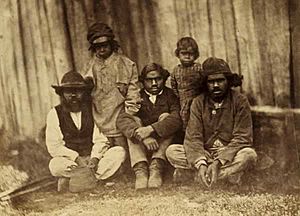
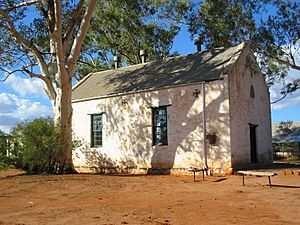
The Caledon Bay crisis of 1932–34 saw one of the last incidents of violent interaction on the 'frontier' of indigenous and non-indigenous Australia, which began when the spearing of Japanese poachers who had been molesting Yolngu women was followed by the killing of a policeman. As the crisis unfolded, national opinion swung behind the Aboriginal people involved, and the first appeal on behalf of an Indigenous Australian to the High Court of Australia was launched. Following the crisis, the anthropologist Donald Thomson was dispatched by the government to live among the Yolngu. Elsewhere around this time, activists like Sir Douglas Nicholls were commencing their campaigns for Aboriginal rights within the established Australian political system and the age of frontier conflict closed.
Co-operation
Frontier encounters in Australia were not universally negative. Positive accounts of Aboriginal customs and encounters are also recorded in the journals of early European explorers, who often relied on Aboriginal guides and assistance: Charles Sturt employed Aboriginal envoys to explore the Murray-Darling; the lone survivor of the Burke and Wills expedition was nursed by local Aboriginal Australians, and the famous Aboriginal explorer Jackey Jackey loyally accompanied his ill-fated friend Edmund Kennedy to Cape York. Respectful studies were conducted by such as Walter Baldwin Spencer and Frank Gillen in their renowned anthropological study The Native Tribes of Central Australia (1899); and by Donald Thomson of Arnhem Land (c. 1935–1943). In inland Australia, the skills of Aboriginal stockmen became highly regarded and in the 20th century, Aboriginal stockmen like Vincent Lingiari became national figures in their campaigns for better pay and improved working conditions.
Removal of children
The removal of indigenous children, by which mixed-race children of Australian Aboriginal and Torres Strait Islander descent were removed from their families by Australian Federal and State government agencies and church missions, was a policy actively conducted in the period between approximately 1905 and 1969. The Human Rights and Equal Opportunity Commission argued that these removals constituted attempted genocide and had a major impact on the Indigenous population. Such interpretations of Aboriginal history are disputed by a few historians such as Keith Windschuttle as being exaggerated or fabricated for political or ideological reasons. This debate is part of what is known within Australia as the History Wars.
Early European explorers
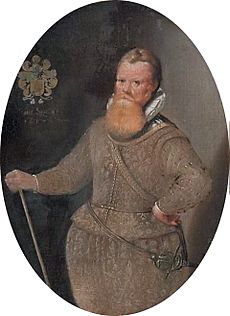
Although a theory of Portuguese discovery in the 1520s exists, it lacks definitive evidence. The Dutch ship, Duyfken, led by Willem Janszoon, made the first documented European landing in Australia in 1606. That same year, a Spanish expedition sailing in nearby waters and led by Portuguese navigator Pedro Fernandes de Queirós had landed in the New Hebrides and, believing them to be the fabled southern continent, named the land "Austrialia del Espiritu Santo" (Southern Land of the Holy Spirit), in honour of his queen Margaret of Austria, the wife of Philip III of Spain. Later that year, Queirós' deputy Luís Vaz de Torres sailed to the north of Australia through Torres Strait, along New Guinea's southern coast.
The Dutch, following shipping routes to the Dutch East Indies, or in search of gold, spices or Christian converts proceeded to contribute a great deal to Europe's knowledge of Australia's coast. In 1616, Dirk Hartog, sailing off course, en route from the Cape of Good Hope to Batavia, landed on an island off Shark Bay, West Australia. In 1622–23 the Leeuwin made the first recorded rounding of the south west corner of the continent, and gave her name to Cape Leeuwin.
In 1627 the south coast of Australia was accidentally discovered by François Thijssen and named 't Land van Pieter Nuyts, in honour of the highest ranking passenger, Pieter Nuyts, extraordinary Councillor of India, In 1628 a squadron of Dutch ships was sent by the Governor-General of the Dutch East Indies Pieter de Carpentier to explore the northern coast. These ships made extensive examinations, particularly in the Gulf of Carpentaria, named in honour of de Carpentier.
Abel Tasman's voyage of 1642 was the first known European expedition to reach Van Diemen's Land (later Tasmania) and New Zealand, and to sight Fiji. On his second voyage of 1644, he also contributed significantly to the mapping of Australia proper, making observations on the land and people of the north coast below New Guinea.
A map of the world inlaid into the floor of the Burgerzaal ("Burger's Hall") of the new Amsterdam Stadhuis ("Town Hall") in 1655 revealed the extent of Dutch charts of much of Australia's coast Based on the 1648 map by Joan Blaeu, Nova et Accuratissima Terrarum Orbis Tabula, it incorporated Tasman's discoveries, subsequently reproduced in the map, Archipelagus Orientalis sive Asiaticus published in the Kurfürsten Atlas (Atlas of the Great Elector).
In 1664 the French geographer, Melchisédech Thévenot, published in Relations de Divers Voyages Curieux a map of New Holland. Thévenot divided the continent in two, between Nova Hollandia to the west and Terre Australe to the east. Emanuel Bowen reproduced Thevenot's map in his Complete System of Geography (London, 1747), re-titling it A Complete Map of the Southern Continent and adding three inscriptions promoting the benefits of exploring and colonising the country. One inscription said:
It is impossible to conceive a Country that promises fairer from its Situation than this of TERRA AUSTRALIS, no longer incognita, as this Map demonstrates, but the Southern Continent Discovered. It lies precisely in the richest climates of the World... and therefore whoever perfectly discovers and settles it will become infalliably possessed of Territories as Rich, as fruitful, and as capable of Improvement, as any that have hitherto been found out, either in the East Indies or the West.
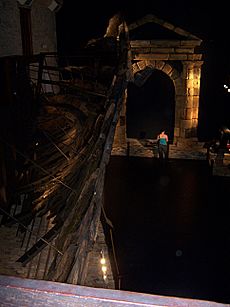

Bowen's map was re-published in John Campbell's editions of John Harris' Navigantium atque Itinerantium Bibliotheca, or Voyages and Travels (1744–1748, 1764). This book recommended exploration of the east coast of New Holland, with a view to a British colonisation, by way of Abel Tasman's route to Van Diemen's Land.
Although various proposals for colonisation were made, notably by Pierre Purry from 1717 to 1744, none was officially attempted. Indigenous Australians were less able to trade with Europeans than were the peoples of India, the East Indies, China, and Japan. The Dutch East India Company concluded that there was "no good to be done there". They turned down Purry's scheme with the comment that, "There is no prospect of use or benefit to the Company in it, but rather very certain and heavy costs".
With the exception of further Dutch visits to the west, however, Australia remained largely unvisited by Europeans until the first British explorations. John Callander put forward a proposal in 1766 for Britain to found a colony of banished convicts in the South Sea or in Terra Australis to enable the mother country to exploit the riches of those regions. He said: "this world must present us with many things entirely new, as hitherto we have had little more knowledge of it, than if it had lain in another planet".
In 1769, Lieutenant James Cook in command of the HMS Endeavour, travelled to Tahiti to observe and record the transit of Venus. Cook also carried secret Admiralty instructions to locate the supposed Southern Continent: "There is reason to imagine that a continent, or land of great extent, may be found to the southward of the track of former navigators." This continent was not found, a disappointment to Alexander Dalrymple and his fellow members of the Royal Society who had urged the Admiralty to undertake this mission. Cook decided to survey the east coast of New Holland, the only major part of that continent that had not been charted by Dutch navigators.
On 19 April 1770, the Endeavour sighted the east coast of Australia and ten days later landed at Botany Bay. Cook charted the coast to its northern extent and, along with the ship's naturalist, Joseph Banks, who subsequently reported favourably on the possibilities of establishing a colony at Botany Bay. Cook formally took possession of the east coast of New Holland on 21/22 August 1770, and noted in his journal that he could "land no more upon this Eastern coast of New Holland, and on the Western side I can make no new discovery the honour of which belongs to the Dutch Navigators and as such they may lay Claim to it as their property [italicised words crossed out in the original] but the Eastern Coast from the Latitude of 38 South down to this place I am confident was never seen or viseted by any European before us and therefore by the same Rule belongs to great Brittan [italicised words crossed out in the original].
In 1772, a French expedition led by Louis Aleno de St Aloüarn, became the first Europeans to formally claim sovereignty over the west coast of Australia, but no attempt was made to follow this with colonisation. The ambition of Sweden's King Gustav III to establish a colony for his country at the Swan River in 1786 remained stillborn. It was not until 1788 that economic, technological and political conditions in Great Britain made it possible and worthwhile for that country to make the large effort of sending the First Fleet to New South Wales.
Colonisation
Plans for colonisation
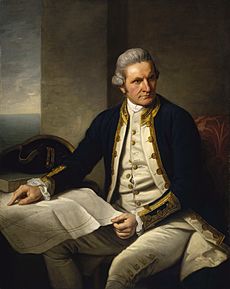
Seventeen years after Cook's landfall on the east coast of Australia, the British government decided to establish a colony at Botany Bay. The American Revolutionary War (1775–1783) saw Britain lose most of its North American colonies and consider establishing replacement territories. In 1779 Sir Joseph Banks, the eminent scientist who had accompanied James Cook on his 1770 voyage, recommended Botany Bay as a suitable site for settlement, saying that "it was not to be doubted that a Tract of Land such as New Holland, which was larger than the whole of Europe, would furnish Matter of advantageous Return." Under Banks' guidance, the American Loyalist James Matra, who had also travelled with Cook, produced "A Proposal for Establishing a Settlement in New South Wales" (23 August 1783), proposing the establishment of a colony composed of American Loyalists, Chinese and South Sea Islanders (but not convicts).

Matra reasoned that: the country was suitable for plantations of sugar, cotton and tobacco; New Zealand timber and hemp or flax could prove valuable commodities; it could form a base for Pacific trade; and it could be a suitable compensation for displaced American Loyalists. Following an interview with Secretary of State Lord Sydney in 1784, Matra amended his proposal to include convicts as settlers, considering that this would benefit both "Economy to the Publick, & Humanity to the Individual".
Matra's plan provided the original blueprint for settlement. Records show the government was considering it in 1784. The London newspapers announced in November 1784 that: "A plan has been presented to the [Prime] Minister, and is now before the Cabinet, for instituting a new colony in New Holland. In this vast tract of land....every sort of produce and improvement of which the various soils of the earth are capable, may be expected". The Government also incorporated the settlement of Norfolk Island into their plan, with its attractions of timber and flax, proposed by Banks' Royal Society colleagues, Sir John Call and Sir George Young.
At the same time, humanitarians and reformers were campaigning in Britain against the appalling conditions in British prisons and hulks. In 1777 prison reformer John Howard wrote The State of Prisons in England and Wales, exposing the harsh conditions of the prison system to "genteel society"." Penal transportation was already well-established as a central plank of English criminal law and until the American Revolution about a thousand criminals per year were sent to Maryland and Virginia. It served as a powerful deterrent to law-breaking. According to historian David Hill, "Europeans knew little about the geography of the globe" and to "convicts in England, transportation to Botany Bay was a frightening prospect." Echoing John Callander, he said Australia "might as well have been another planet."
In 1933, Sir Ernest Scott, stated the traditional view of the reasons for colonisation: "It is clear that the only consideration which weighed seriously with the Pitt Government was the immediately pressing and practical one of finding a suitable place for a convict settlement ". In the early 1960s, historian Geoffrey Blainey questioned the traditional view of foundation purely as a convict dumping ground. His book The Tyranny of Distance suggested ensuring supplies of flax and timber after the loss of the American colonies may have also been motivations, and Norfolk Island was the key to the British decision. A number of historians responded and debate brought to light a large amount of additional source material on the reasons for settlement. This has most recently been set out and discussed by Professor Alan Frost.
The decision to settle was taken when it seemed the outbreak of civil war in the Netherlands might precipitate a war in which Britain would be again confronted with the alliance of the three naval Powers, France, Holland and Spain, which had brought her to defeat in 1783. Under these circumstances, the strategic advantages of a colony in New South Wales described in James Matra's proposal were attractive. Matra wrote that such a settlement could facilitate attacks upon the Spanish in South America and the Philippines, and against the Dutch East Indies. In 1790, during the Nootka Crisis, plans were made for naval expeditions against Spain's possessions in the Americas and the Philippines, in which New South Wales was assigned the role of a base for "refreshment, communication and retreat". On subsequent occasions into the early 19th century when war threatened or broke out between Britain and Spain, these plans were revived and only the short length of the period of hostilities in each case prevented them from being put into effect.
Georg Forster, who had sailed under Lieutenant James Cook in the voyage of the Resolution (1772–1775), wrote in 1786 on the future prospects of the British colony: "New Holland, an island of enormous extent or it might be said, a third continent, is the future homeland of a new civilized society which, however mean its beginning may seem to be, nevertheless promises within a short time to become very important." And the merchant adventurer and would-be coloniser of southwestern Australia under the Swedish flag, William Bolts, said to the Swedish Ambassador in Paris, Erik von Staël in December 1789, that the British had founded at Botany Bay, "a settlement which in time will become of the greatest importance to the Commerce of the Globe".
Establishment of British colonies
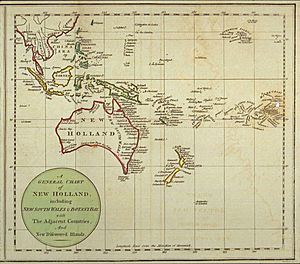
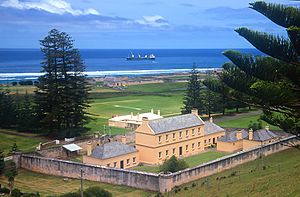
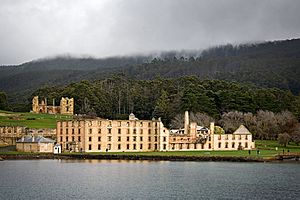
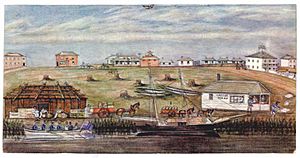
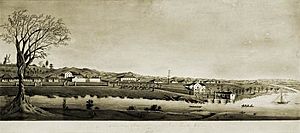
The territory claimed by Britain included all of Australia eastward of the meridian of 135° East and all the islands in the Pacific Ocean between the latitudes of Cape York and the southern tip of Van Diemen's Land (Tasmania). The western limit of 135° East was set at the meridian dividing New Holland from Terra Australis shown on Emanuel Bowen's Complete Map of the Southern Continent, published in John Campbell's editions of John Harris' Navigantium atque Itinerantium Bibliotheca, or Voyages and Travels (1744–1748, and 1764). It was a vast claim which elicited excitement at the time: the Dutch translator of First Fleet officer and author Watkin Tench's A Narrative of the Expedition to Botany Bay wrote: "a single province which, beyond all doubt, is the largest on the whole surface of the earth. From their definition it covers, in its greatest extent from East to West, virtually a fourth of the whole circumference of the Globe". Spanish naval commander Alessandro Malaspina, who visited Sydney in March–April 1793 reported to his government that: "The transportation of the convicts constituted the means and not the object of the enterprise. The extension of dominion, mercantile speculations and the discovery of mines were the real object". Frenchman François Péron, of the Baudin expedition visited Sydney in 1802 and reported to the French Government: "How can it be conceived that such a monstrous invasion was accomplished, with no complaint in Europe to protest against it? How can it be conceived that Spain, who had previously raised so many objections opposing the occupation of the Malouines (Falkland Islands), meekly allowed a formidable empire to arise to facing her richest possessions, an empire which must either invade or liberate them?"
The colony included the current islands of New Zealand. In 1817, the British government withdrew the extensive territorial claim over the South Pacific. In practice, the governors' writ had been shown not to run in the islands of the South Pacific. The Church Missionary Society had concerns over atrocities committed against the natives of the South Sea Islands, and the ineffectiveness of the New South Wales government to deal with the lawlessness. As a result, on 27 June 1817, Parliament passed an Act for the more effectual Punishment of Murders and Manslaughters committed in Places not within His Majesty's Dominions, which described Tahiti, New Zealand and other islands of the South Pacific as being not within His Majesty's dominions.
1788: New South Wales
The British colony of New South Wales was established with the arrival of the First Fleet of 11 vessels under the command of Captain Arthur Phillip in January 1788. It consisted of over a thousand settlers, including 778 convicts (192 women and 586 men). A few days after arrival at Botany Bay the fleet moved to the more suitable Port Jackson where a settlement was established at Sydney Cove on 26 January 1788. This date later became Australia's national day, Australia Day. The colony was formally proclaimed by Governor Phillip on 7 February 1788 at Sydney. Sydney Cove offered a fresh water supply and a safe harbour, which Philip described as being, 'with out exception the finest Harbour in the World [...] Here a Thousand Sail of the Line may ride in the most perfect Security'.
Governor Phillip was vested with complete authority over the inhabitants of the colony. Enlightened for his Age, Phillip's personal intent was to establish harmonious relations with local Aboriginal people and try to reform as well as discipline the convicts of the colony. Phillip and several of his officers—most notably Watkin Tench—left behind journals and accounts of which tell of immense hardships during the first years of settlement. Often Phillip's officers despaired for the future of New South Wales. Early efforts at agriculture were fraught and supplies from overseas were scarce. Between 1788 and 1792 about 3546 male and 766 female convicts were landed at Sydney—many "professional criminals" with few of the skills required for the establishment of a colony. Many new arrivals were also sick or unfit for work and the conditions of healthy convicts only deteriorated with hard labour and poor sustenance in the settlement. The food situation reached crisis point in 1790 and the Second Fleet which finally arrived in June 1790 had lost a quarter of its 'passengers' through sickness, while the condition of the convicts of the Third Fleet appalled Phillip. From 1791 however, the more regular arrival of ships and the beginnings of trade lessened the feeling of isolation and improved supplies.
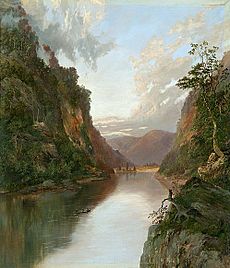
Phillip sent exploratory missions in search of better soils, fixed on the Parramatta region as a promising area for expansion, and moved many of the convicts from late 1788 to establish a small township, which became the main centre of the colony's economic life. This left Sydney Cove only as an important port and focus of social life. Poor equipment and unfamiliar soils and climate continued to hamper the expansion of farming from Farm Cove to Parramatta and Toongabbie, but a building program, assisted by convict labour, advanced steadily. Between 1788 and 1792, convicts and their gaolers made up the majority of the population—but after this, a population of emancipated convicts began to grow who could be granted land and these people pioneered a non-government private sector economy and were later joined by soldiers whose military service had expired—and finally, free settlers who began arriving from Britain. Governor Phillip departed the colony for England on 11 December 1792, with the new settlement having survived near starvation and immense isolation for four years. On 16 February 1793 the first free settlers arrived. The settlers: Thomas Rose, with his wife and four children, Edward Powell, Thomas Webb, Joseph Webb, and Frederick Meredith.
Establishment of further colonies
After the founding of the colony of New South Wales in 1788, Australia was divided into an eastern half, named New South Wales, under the administration of the colonial government in Sydney, and a western half named New Holland. The western boundary of 135° East of Greenwich was based on the Complete Map of the Southern Continent, published in Emanuel Bowen's Complete System of Geography (London 1747), and reproduced in John Campbell's editions of John Harris' Navigantium atque Itinerantium Bibliotheca, or Voyages and Travels (1744–48, and 1764). Bowen's map was based on one by Melchisédech Thévenot and published in Relations des Divers Voyages (1663), which apparently divided New Holland in the west from Terra Australis in the east by a latitude staff situated at 135° East. This division, reproduced in Bowen's map, provided a convenient western boundary for the British claim because, as Watkin Tench subsequently commented in A Narrative of the Expedition to Botany Bay, "By this partition, it may be fairly presumed, that every source of future litigation between the Dutch and us, will be for ever cut off, as the discoveries of English navigators only are comprized in this territory". Thévenot said he copied his map from the one engraved in the floor of the Amsterdam Town Hall, but in that map there was no dividing line between New Holland and Terra Australis. Thévenot's map was actually copied from Joan Blaeu's map, Archipelagus Orientalis sive Asiaticus, published in 1659 in the Kurfürsten Atlas (Atlas of the Great Elector); this map was a part of Blaeu's world map of 1648, Nova et Accuratissima Terrarum Orbis Tabula, which first showed the land revealed by Abel Tasman's 1642 voyage as Hollandia Nova and which served as the basis for the Amsterdam Town Hall pavement map. Longitude 135° East reflected the line of division between the claims of Spain and Portugal established in the Treaty of Tordesillas in 1494, which had formed the basis of many subsequent claims to colonial territory. An Historical Narrative of the Discovery of New Holland and New South Wales, published in November 1786, contained "A General Chart of New Holland, including New South Wales & Botany Bay, with The Adjacent Countries, and New Discovered Islands", which showed all the territory claimed under the jurisdiction of the Governor of New South Wales.
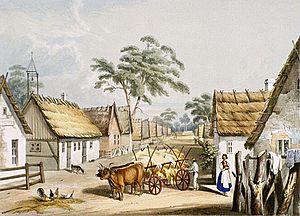
Romantic descriptions of the beauty, mild climate, and fertile soil of Norfolk Island in the South Pacific led the British government to establish a subsidiary settlement of the New South Wales colony there in 1788. It was hoped that the giant Norfolk Island pine trees and flax plants growing wild on the island might provide the basis for a local industry which, particularly in the case of flax, would provide an alternative source of supply to Russia for an article which was essential for making cordage and sails for the ships of the British navy. However, the island had no safe harbour, which led the colony to be abandoned and the settlers evacuated to Tasmania in 1807. The island was subsequently re-settled as a penal settlement in 1824.
In 1798, George Bass and Matthew Flinders circumnavigated Van Diemen's Land, proving that it was an island. In 1802, Flinders successfully circumnavigated Australia for the first time.
Van Diemen's Land, now known as Tasmania, was settled in 1803, following a failed attempt to settle at Sullivan Bay in what is now Victoria. Other British settlements followed, at various points around the continent, many of them unsuccessful. The East India Trade Committee recommended in 1823 that a settlement be established on the coast of northern Australia to forestall the Dutch, and Captain J.J.G. Bremer, RN, was commissioned to form a settlement between Bathurst Island and the Cobourg Peninsula. Bremer fixed the site of his settlement at Fort Dundas on Melville Island in 1824 and, because this was well to the west of the boundary proclaimed in 1788, proclaimed British sovereignty over all the territory as far west as longitude 129° East.
The new boundary included Melville and Bathurst Islands, and the adjacent mainland. In 1826, the British claim was extended to the whole Australian continent when Major Edmund Lockyer established a settlement on King George Sound (the basis of the later town of Albany), but the eastern border of Western Australia remained unchanged at longitude 129° East. In 1824, a penal colony was established near the mouth of the Brisbane River (the basis of the later colony of Queensland). In 1829, the Swan River Colony and its capital of Perth were founded on the west coast proper and also assumed control of King George Sound. Initially a free colony, Western Australia later accepted British convicts, because of an acute labour shortage.
The colony of South Australia was settled in 1836, with its western and eastern boundaries set at 132° and 141° East of Greenwich, and to the north at latitude 26° South. The western and eastern boundary points were chosen as they marked the extent of coastline first surveyed by Matthew Flinders in 1802 (Nicolas Baudin's priority being ignored). The northern boundary was set at the parallel of latitude 26° South by the British Parliament because that was considered to be the limit of effective control of territory that could be exercised by a settlement founded on the shores of Gulf St Vincent; the South Australian Company had proposed the parallel of 20° South, later reduced to the Tropic of Capricorn (the parallel of latitude 23° 37′ South).
Convicts and colonial society
Between 1788 and 1868, approximately 161,700 convicts (of whom 25,000 were women) were transported to the Australian colonies of New South Wales, Van Diemen's land and Western Australia. Historian Lloyd Robson has estimated that perhaps two-thirds were thieves from working class towns, particularly from the Midlands and north of England. The majority were repeat offenders. Whether transportation managed to achieve its goal of reforming or not, some convicts were able to leave the prison system in Australia; after 1801 they could gain "tickets of leave" for good behaviour and be assigned to work for free men for wages. A few went on to have successful lives as emancipists, having been pardoned at the end of their sentence. Female convicts had fewer opportunities.

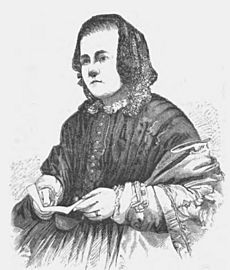
Some convicts, particularly Irish convicts, had been transported to Australia for political crimes or social rebellion, so authorities were consequently suspicious of the Irish and restricted the practice of Catholicism in Australia. The Irish led Castle Hill Rebellion of 1804 served to increase suspicions and repression. Church of England clergy meanwhile worked closely with the governors and Richard Johnson, chaplain to the First Fleet was charged by Governor Arthur Phillip, with improving "public morality" in the colony and was also heavily involved in health and education. The Reverend Samuel Marsden (1765–1838) had magisterial duties, and so was equated with the authorities by the convicts, becoming known as the 'flogging parson' for the severity of his punishments.
The New South Wales Corps was formed in England in 1789 as a permanent regiment to relieve the marines who had accompanied the First Fleet. Officers of the Corps soon became involved in the corrupt and lucrative rum trade in the colony. In the Rum Rebellion of 1808, the Corps, working closely with the newly established wool trader John Macarthur, staged the only successful armed takeover of government in Australian history, deposing Governor William Bligh and instigating a brief period of military rule in the colony prior to the arrival from Britain of Governor Lachlan Macquarie in 1810.
Macquarie served as the last autocratic Governor of New South Wales, from 1810 to 1821 and had a leading role in the social and economic development of New South Wales which saw it transition from a penal colony to a budding free society. He established public works, a bank, churches, and charitable institutions and sought good relations with the Aboriginal Australians. In 1813 he sent Blaxland, Wentworth and Lawson across the Blue Mountains, where they found the great plains of the interior. Central, however to Macquarie's policy was his treatment of the emancipists, whom he decreed should be treated as social equals to free-settlers in the colony. Against opposition, he appointed emancipists to key government positions including Francis Greenway as colonial architect and William Redfern as a magistrate. London judged his public works to be too expensive and society was scandalised by his treatment of emancipists. Egalitarianism would come to be considered a central virtue among Australians.
The first five Governors of New South Wales realised the urgent need to encourage free settlers, but the British government remained largely indifferent. As early as 1790, Governor Arthur Phillip wrote: "Your lordship will see by my...letters the little progress we have been able to make in cultivating the lands ... At present this settlement only affords one person that I can employ in cultivating the lands..." It was not until the 1820s that numbers of free settlers began to arrive and government schemes began to be introduced to encourage free settlers. Philanthropists Caroline Chisholm and John Dunmore Lang developed their own migration schemes. Land grants of crown land were made by Governors, and settlement schemes such as those of Edward Gibbon Wakefield carried some weight in encouraging migrants to make the long voyage to Australia, as opposed to the United States or Canada.
Early colonial administrations were anxious to address the gender imbalance in the population brought about by the importation of large numbers of convict men. Between 1788 and 1792, around 3546 male to 766 female convicts were landed at Sydney. Women came to play an important role in education and welfare during colonial times. Governor Macquarie's wife, Elizabeth Macquarie took an interest in convict women's welfare. Her contemporary Elizabeth Macarthur was noted for her 'feminine strength' in assisting the establishment of the Australian merino wool industry during her husband John Macarthur's enforced absence from the colony following the Rum Rebellion. The Catholic Sisters of Charity arrived in 1838 and set about pastoral care in a women's prison, visiting hospitals and schools and establishing employment for convict women. The sisters went on to establish hospitals in four of the eastern states, beginning with St Vincent's Hospital, Sydney in 1857 as a free hospital for all people, but especially for the poor. Caroline Chisholm (1808–1877) established a migrant women's shelter and worked for women's welfare in the colonies in the 1840s. Her humanitarian efforts later won her fame in England and great influence in achieving support for families in the colony. Sydney's first Catholic Bishop, John Bede Polding founded an Australian order of nuns—the Sisters of the Good Samaritan—in 1857 to work in education and social work. The Sisters of St Joseph, were founded in South Australia by Saint Mary MacKillop and Fr Julian Tenison Woods in 1867. MacKillop travelled throughout Australasia and established schools, convents and charitable institutions. She was canonised by Benedict XVI in 2010, becoming the first Australian to be so honoured by the Catholic Church.
From the 1820s, increasing numbers of squatters occupied land beyond the fringes of European settlement. Often running sheep on large stations with relatively few overheads, squatters could make considerable profits. By 1834, nearly 2 million kilograms of wool were being exported to Britain from Australia. By 1850, barely 2,000 squatters had gained 30 million hectares of land, and they formed a powerful and "respectable" interest group in several colonies.
In 1835, the British Colonial Office issued the Proclamation of Governor Bourke, implementing the legal doctrine of terra nullius upon which British settlement was based, reinforcing the notion that the land belonged to no one prior to the British Crown taking possession of it and quashing any likelihood of treaties with Aboriginal peoples, including that signed by John Batman. Its publication meant that from then, all people found occupying land without the authority of the government would be considered illegal trespassers.
Separate settlements and later, colonies, were created from parts of New South Wales: South Australia in 1836, New Zealand in 1840, Port Phillip District in 1834, later becoming the colony of Victoria in 1851, and Queensland in 1859. The Northern Territory was founded in 1863 as part of South Australia. The transportation of convicts to Australia was phased out between 1840 and 1868.
Massive areas of land were cleared for agriculture and various other purposes in the first 100 years of European settlement. In addition to the obvious impacts this early clearing of land and importation of hard-hoofed animals had on the ecology of particular regions, it severely affected indigenous Australians, by reducing the resources they relied on for food, shelter and other essentials. This progressively forced them into smaller areas and reduced their numbers as the majority died of newly introduced diseases and lack of resources. Indigenous resistance against the settlers was widespread, and prolonged fighting between 1788 and the 1920s led to the deaths of at least 20,000 indigenous people and between 2,000 and 2,500 Europeans. During the mid-late 19th century, many indigenous Australians in south eastern Australia were relocated, often forcibly, to reserves and missions. The nature of many of these institutions enabled disease to spread quickly and many were closed as their populations fell.
Free colony at South Australia
A group in Britain led by Edward Gibbon Wakefield sought to start a colony based on free settlement rather than convict labour. In 1831 the South Australian Land Company was formed amid a campaign for a royal charter which would provide for the establishment of a privately financed "free" colony in Australia.
While New South Wales, Tasmania and (although not initially) Western Australia were established as convict settlements, the founders of South Australia had a vision of a colony with political and religious freedoms, together with opportunities for wealth through business and pastoral investments. The South Australia Act 1834, passed by the British Government which established the colony reflected these desires and included a promise of representative government when the population reached 50,000 people. South Australia thus became the only colony authorised by an Act of Parliament, and which was intended to be developed at no cost to the British government. Transportation of convicts was forbidden, and 'poor Emigrants', assisted by an Emigration Fund, were required to bring their families with them. Significantly, the Letters Patent enabling the South Australia Act 1834 included a guarantee of the rights of 'any Aboriginal Natives' and their descendants to lands they 'now actually occupied or enjoyed'.
In 1836, two ships of the South Australia Land Company left to establish the first settlement on Kangaroo Island. The foundation of South Australia is now generally commemorated as Governor John Hindmarsh's Proclamation of the new Province at Glenelg, on the mainland, on 28 December 1836. From 1843 to 1851, the Governor ruled with the assistance of an appointed Executive Council of paid officials. Land development and settlement was the basis of the Wakefield vision, so land law and regulations governing it were fundamental to the foundation of the Province and allowed for land to be bought at a uniform price per acre (regardless of quality), with auctions for land desired by more than one buyer, and leases made available on unused land. Proceeds from land were to fund the Emigration Fund to assist poor settlers to come as tradesmen and labourers. Agitation for representative government quickly emerged. Most other colonies had been founded by Governors with near total authority, but in South Australia, power was initially divided between the Governor and the Resident Commissioner, so that government could not interfere with the business affairs or freedom of religion of the settlers. By 1851 the colony was experimenting with a partially elected council.
Exploration of the continent
In 1798–99 George Bass and Matthew Flinders set out from Sydney in a sloop and circumnavigated Tasmania, thus proving it to be an island. In 1801–02 Matthew Flinders in HMS Investigator led the first circumnavigation of Australia. Aboard ship was the Aboriginal explorer Bungaree, of the Sydney district, who became the first person born on the Australian continent to circumnavigate the Australian continent. Previously, the famous Bennelong and a companion had become the first people born in the area of New South Wales to sail for Europe, when, in 1792 they accompanied Governor Phillip to England and were presented to King George III.
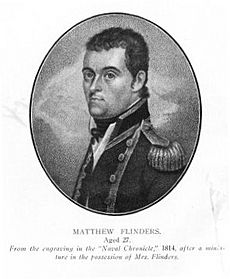
In 1813, Gregory Blaxland, William Lawson and William Wentworth succeeded in crossing the formidable barrier of forested gulleys and sheer cliffs presented by the Blue Mountains, west of Sydney. At Mount Blaxland they looked out over "enough grass to support the stock of the colony for thirty years", and expansion of the British settlement into the interior could begin.
In 1824 the Governor Sir Thomas Brisbane, commissioned Hamilton Hume and former Royal Navy Captain William Hovell to lead an expedition to find new grazing land in the south of the colony, and also to find an answer to the mystery of where New South Wales' western rivers flowed. Over 16 weeks in 1824–25, Hume and Hovell journeyed to Port Phillip and back. They made many important discoveries including the Murray River (which they named the Hume), many of its tributaries, and good agricultural and grazing lands between Gunning, New South Wales and Corio Bay, Port Phillip.
Charles Sturt led an expedition along the Macquarie River in 1828 and discovered the Darling River. A theory had developed that the inland rivers of New South Wales were draining into an inland sea. Leading a second expedition in 1829, Sturt followed the Murrumbidgee River into a 'broad and noble river', the Murray River, which he named after Sir George Murray, secretary of state for the colonies. His party then followed this river to its junction with the Darling River, facing two threatening encounters with local Aboriginal people along the way. Sturt continued down river on to Lake Alexandrina, where the Murray meets the sea in South Australia. Suffering greatly, the party had to row hundreds of kilometres back upstream for the return journey.
Surveyor General Sir Thomas Mitchell conducted a series of expeditions from the 1830s to 'fill in the gaps' left by these previous expeditions. He was meticulous in seeking to record the original Aboriginal place names around the colony, for which reason the majority of place names to this day retain their Aboriginal titles.
The Polish scientist/explorer Count Paul Edmund Strzelecki conducted surveying work in the Australian Alps in 1839 and became the first European to ascend Australia's highest peak, which he named Mount Kosciuszko in honour of the Polish patriot Tadeusz Kościuszko.

European explorers made their last great, often arduous and sometimes tragic expeditions into the interior of Australia during the second half of the 19th century—some with the official sponsorship of the colonial authorities and others commissioned by private investors. By 1850, large areas of the inland were still unknown to Europeans. Trailblazers like Edmund Kennedy and the Prussian naturalist Ludwig Leichhardt, had met tragic ends attempting to fill in the gaps during the 1840s, but explorers remained ambitious to discover new lands for agriculture or answer scientific enquiries. Surveyors also acted as explorers and the colonies sent out expeditions to discover the best routes for lines of communication. The size of expeditions varied considerably from small parties of just two or three to large, well-equipped teams led by gentlemen explorers assisted by smiths, carpenters, labourers and Aboriginal guides accompanied by horses, camels or bullocks.
In 1860, the ill-fated Burke and Wills led the first north-south crossing of the continent from Melbourne to the Gulf of Carpentaria. Lacking bushcraft and unwilling to learn from the local Aboriginal people, Burke and Wills died in 1861, having returned from the Gulf to their rendezvous point at Coopers Creek only to discover the rest of their party had departed the location only a matter of hours previously. Though an impressive feat of navigation, the expedition was an organisational disaster which continues to fascinate the Australian public.
In 1862, John McDouall Stuart succeeded in traversing Central Australia from south to north. His expedition mapped out the route which was later followed by the Australian Overland Telegraph Line.
Uluru and Kata Tjuta were first mapped by Europeans in 1872 during the expeditionary period made possible by the construction of the Australian Overland Telegraph Line. In separate expeditions, Ernest Giles and William Gosse were the first European explorers to this area. While exploring the area in 1872, Giles sighted Kata Tjuta from a location near Kings Canyon and called it Mount Olga, while the following year Gosse observed Uluru and named it Ayers Rock, in honour of the Chief Secretary of South Australia, Sir Henry Ayers. These barren desert lands of Central Australia disappointed the Europeans as unpromising for pastoral expansion, but would later come to be appreciated as emblematic of Australia.
From autonomy to federation
Colonial self-government and the gold rushes
The discovery of gold in Australia is traditionally attributed to Edward Hammond Hargraves, near Bathurst, New South Wales, in February 1851. Traces of gold had nevertheless been found in Australia as early as 1823 by surveyor James McBrien. As by English law all minerals belonged to the Crown, there was at first, "little to stimulate a search for really rich goldfields in a colony prospering under a pastoral economy." Richard Broome also argues that the California Gold Rush at first overawed the Australian finds, until "the news of Mount Alexander reached England in May 1852, followed shortly by six ships carrying eight tons of gold."

The gold rushes brought many immigrants to Australia from the British Isles, continental Europe, North America and China. The Colony of Victoria's population grew rapidly, from 76,000 in 1850 to 530,000 by 1859. Discontent arose amongst diggers almost immediately, particularly on the crowded Victorian fields. The causes of this were the colonial government's administration of the diggings and the gold licence system. Following a number of protests and petitions for reform, violence erupted at Ballarat in late 1854.
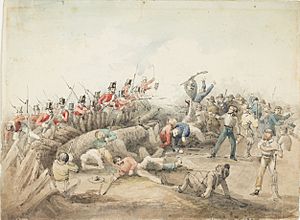
Early on the morning of Sunday 3 December 1854, British soldiers and Police attacked a stockade built on the Eureka lead holding some of the aggrieved diggers. In a short fight, at least 30 miners were killed and an unknown number wounded. O'Brien lists 5 soldiers of the 12th and 40th Regiments killed and 12 wounded. Blinded by his fear of agitation with democratic overtones, local Commissioner Robert Rede had felt "it was absolutely necessary that a blow should be struck" against the miners.
But a few months later, a Royal commission made sweeping changes to the administration of Victoria's goldfields. Its recommendations included the abolition of the licence, reforms to the police force and voting rights for miners holding a Miner's Right. The Eureka Flag that was used to represent the Ballarat miners has been seriously considered by some as an alternative to the Australian flag, because of its controversial association with democratic developments.
In the 1890s, visiting author Mark Twain characterised the battle at Eureka as "The finest thing in Australasian history. It was a revolution-small in size, but great politically; it was a strike for liberty, a struggle for principle, a stand against injustice and oppression...it is another instance of a victory won by a lost battle."

Alternatively, in 1999, the Premier of New South Wales, Bob Carr, dismissed the Eureka Stockade as a "protest without consequence". During the 2004 Australian federal election, Deputy Prime Minister John Anderson stated his view that "I think people have tried to make too much of the Eureka Stockade...trying to give it a credibility and standing that it probably doesn't enjoy."
Later gold rushes occurred at the Palmer River, Queensland, in the 1870s, and Coolgardie and Kalgoorlie in Western Australia, in the 1890s. Confrontations between Chinese and European miners occurred on the Buckland River in Victoria and Lambing Flat in New South Wales, in the late 1850s and early 1860s. Driven by European jealousy of the success of Chinese efforts as alluvial (surface) gold ran out, it fixed emerging Australian attitudes in favour of a White Australia policy, according to historian Geoffrey Serle.
New South Wales in 1855 was the first colony to gain responsible government, managing most of its own affairs while remaining part of the British Empire. Victoria, Tasmania, and South Australia followed in 1856; Queensland, from its foundation in 1859; and Western Australia, in 1890. The Colonial Office in London retained control of some matters, notably foreign affairs, defence and international shipping.
The gold era led to a long period of prosperity, sometimes called "the long boom." This was fed by British investment and the continued growth of the pastoral and mining industries, in addition to the growth of efficient transport by rail, river and sea. By 1891, the sheep population of Australia was estimated at 100 million. Gold production had declined since the 1850s, but in the same year was still worth £5.2 million. Eventually the economic expansion ended; the 1890s were a period of economic depression, felt most strongly in Victoria, and its capital Melbourne.
The late 19th century had however, seen a great growth in the cities of south eastern Australia. Australia's population (not including Aboriginal Australians, who were excluded from census calculations) in 1900 was 3.7 million, almost 1 million of whom lived in Melbourne and Sydney. More than two-thirds of the population overall lived in cities and towns by the close of the century, making "Australia one of the most urbanised societies in the western world."
Bushrangers

Bushrangers, originally referred to runaway convicts in the early years of the British settlement of Australia who had the survival skills necessary to use the Australian bush as a refuge to hide from the authorities. The term "bushranger" then evolved to refer to those who abandoned social rights and privileges to take up "robbery under arms" as a way of life, using the bush as their base. These bushrangers were roughly analogous to British "highwaymen" and American "Old West outlaws", and their crimes often included robbing small-town banks or coach services.
More than 2,000 bushrangers are believed to have roamed the Australian countryside, beginning with the convict bolters and ending after Ned Kelly's last stand at Glenrowan.
Bold Jack Donahue is recorded as the last convict bushranger. He was reported in newspapers around 1827 as being responsible for an outbreak of bushranging on the road between Sydney and Windsor. Throughout the 1820s he was regarded as the most notorious bushranger in the colony. Leading a band of escaped convicts, Donahue became central to Australian folklore as the Wild Colonial Boy.
Bushranging was common on the mainland, but Van Diemen's Land (Tasmania) produced the most violent and serious outbreaks of convict bushrangers. Hundreds of convicts were at large in the bush, farms were abandoned and martial law was proclaimed. Indigenous outlaw Musquito defied colonial law and led attacks on settlers.
The bushrangers' heyday was the Gold Rush years of the 1850s and 1860s.
There was much bushranging activity in the Lachlan Valley, around Forbes, Yass and Cowra in New South Wales. Frank Gardiner, John Gilbert and Ben Hall led the most notorious gangs of the period. Other active bushrangers included Dan Morgan, based in the Murray River, and Captain Thunderbolt, killed outside Uralla.
The increasing push of settlement, increased police efficiency, improvements in rail transport and communications technology, such as telegraphy, made it increasingly difficult for bushrangers to evade capture.
Among the last bushrangers were the Kelly Gang, led by Ned Kelly, who were captured at Glenrowan in 1880, two years after they were outlawed. Kelly was born in Victoria to an Irish convict father, and as a young man he clashed with the Victoria Police. Following an incident at his home in 1878, police parties searched for him in the bush. After he killed three policemen, the colony proclaimed Kelly and his gang wanted outlaws.
A final violent confrontation with police took place at Glenrowan on 28 June 1880. Kelly, dressed in home-made plate metal armour and helmet, was captured and sent to jail. He was hanged for murder at Old Melbourne Gaol in November 1880. His daring and notoriety made him an iconic figure in Australian history, folklore, literature, art and film.
Some bushrangers, most notably Ned Kelly in his Jerilderie Letter, and in his final raid on Glenrowan, explicitly represented themselves as political rebels. Attitudes to Kelly, by far the most well-known bushranger, exemplify the ambivalent views of Australians regarding bushranging.
Development of Australian democracy
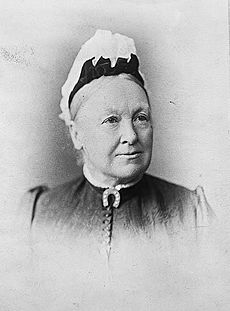
Traditional Aboriginal society had been governed by councils of elders and a corporate decision making process, but the first European-style governments established after 1788 were autocratic and run by appointed governors—although English law was transplanted into the Australian colonies by virtue of the doctrine of reception, thus notions of the rights and processes established by the Magna Carta and the Bill of Rights 1689 were brought from Britain by the colonists. Agitation for representative government began soon after the settlement of the colonies.
The oldest legislative body in Australia, the New South Wales Legislative Council, was created in 1825 as an appointed body to advise the Governor of New South Wales. William Wentworth established the Australian Patriotic Association (Australia's first political party) in 1835 to demand democratic government for New South Wales. The reformist attorney general, John Plunkett, sought to apply Enlightenment principles to governance in the colony, pursuing the establishment of equality before the law, first by extending jury rights to emancipists, then by extending legal protections to convicts, assigned servants and Aboriginal Australians. Plunkett twice charged the colonist perpetrators of the Myall Creek massacre of Aboriginal Australians with murder, resulting in a conviction and his landmark Church Act of 1836 disestablished the Church of England and established legal equality between Anglicans, Catholics, Presbyterians and later Methodists.
In 1840, the Adelaide City Council and the Sydney City Council were established. Men who possessed 1,000 pounds worth of property were able to stand for election and wealthy landowners were permitted up to four votes each in elections. Australia's first parliamentary elections were conducted for the New South Wales Legislative Council in 1843, again with voting rights (for males only) tied to property ownership or financial capacity. Voter rights were extended further in New South Wales in 1850 and elections for legislative councils were held in the colonies of Victoria, South Australia and Tasmania.
By the mid-19th century, there was a strong desire for representative and responsible government in the colonies of Australia, fed by the democratic spirit of the goldfields evident at the Eureka Stockade and the ideas of the great reform movements sweeping Europe, the United States and the British Empire. The end of convict transportation accelerated reform in the 1840s and 1850s. The Australian Colonies Government Act [1850] was a landmark development which granted representative constitutions to New South Wales, Victoria, South Australia and Tasmania and the colonies enthusiastically set about writing constitutions which produced democratically progressive parliaments—though the constitutions generally maintained the role of the colonial upper houses as representative of social and economic "interests" and all established constitutional monarchies with the British monarch as the symbolic head of state.
In 1855, limited self-government was granted by London to New South Wales, Victoria, South Australia and Tasmania. An innovative secret ballot was introduced in Victoria, Tasmania and South Australia in 1856, in which the government supplied voting paper containing the names of candidates and voters could select in private. This system was adopted around the world, becoming known as the "Australian Ballot". 1855 also saw the granting of the right to vote to all male British subjects 21 years or over in South Australia. This right was extended to Victoria in 1857 and New South Wales the following year. The other colonies followed until, in 1896, Tasmania became the last colony to grant universal male suffrage.
Propertied women in the colony of South Australia were granted the vote in local elections (but not parliamentary elections) in 1861. Henrietta Dugdale formed the first Australian women's suffrage society in Melbourne in 1884. Women became eligible to vote for the Parliament of South Australia in 1895. This was the first legislation in the world permitting women also to stand for election to political office and, in 1897, Catherine Helen Spence became the first female political candidate for political office, unsuccessfully standing for election as a delegate to the Federal Convention on Australian Federation. Western Australia granted voting rights to women in 1899.
Legally, indigenous Australian males generally gained the right to vote during this period when Victoria, New South Wales, Tasmania and South Australia gave voting rights to all male British subjects over 21. Only Queensland and Western Australia barred Aboriginal people from voting. Thus, Aboriginal men and women voted in some jurisdictions for the first Commonwealth Parliament in 1901. Early federal parliamentary reform and judicial interpretation however sought to limit Aboriginal voting in practice—a situation which endured until rights activists began campaigning in the 1940s.
Though the various parliaments of Australia have been constantly evolving, the key foundations for elected parliamentary government have maintained an historical continuity in Australia from the 1850s into the 21st century.
Growth of nationalism
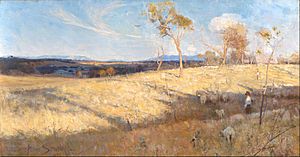
By the late 1880s, a majority of people living in the Australian colonies were native born, although over 90 per cent were of British and Irish heritage. Historian Don Gibb suggests that bushranger Ned Kelly represented one dimension of the emerging attitudes of the native born population. Identifying strongly with family and mates, Kelly was opposed to what he regarded as oppression by Police and powerful Squatters. Almost mirroring the Australian stereotype later defined by historian Russel Ward, Kelly became "a skilled bushman, adept with guns, horses and fists and winning admiration from his peers in the district." Journalist Vance Palmer suggested although Kelly came to typify "the rebellious persona of the country for later generations, (he really) belonged...to another period."
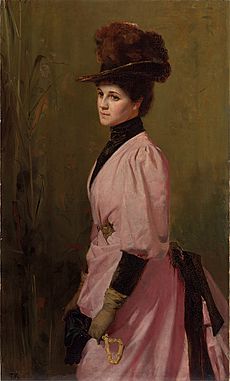
The origins of distinctly Australian painting is often associated with this period and the Heidelberg School of the 1880s–1890s. Artists such as Arthur Streeton, Frederick McCubbin and Tom Roberts applied themselves to recreating in their art a truer sense of light and colour as seen in Australian landscape. Like the European Impressionists, they painted in the open air. These artists found inspiration in the unique light and colour which characterises the Australian bush. Their most recognised work involves scenes of pastoral and wild Australia, featuring the vibrant, even harsh colours of Australian summers.
Australian literature was equally developing a distinct voice. The classic Australian writers Henry Lawson, Banjo Paterson, Miles Franklin, Norman Lindsay, Steele Rudd, Mary Gilmore, C J Dennis and Dorothea Mackellar were all forged by—and indeed helped to forge—this period of growing national identity. Views of Australia at times conflicted—Lawson and Paterson contributed a series of verses to The Bulletin magazine in which they engaged in a literary debate about the nature of life in Australia: Lawson (a republican socialist) derided Paterson as a romantic, while Paterson (a country born city lawyer) thought Lawson full of doom and gloom. Paterson wrote the lyrics of the much-loved folksong Waltzing Matilda in 1895. The song has often been suggested as Australia's national anthem and Advance Australia Fair, the Australian national anthem since the late 1970s, itself was written in 1887. Dennis wrote of laconic heroes in the Australian vernacular, while McKellar rejected a love of England's pleasant pastures in favour of what she termed a "Sunburnt Country" in her iconic poem: My Country (1903).
A common theme throughout the nationalist art, music and writing of the late 19th century was the romantic rural or bush myth, ironically produced by one of the most urbanised societies in the world. Paterson's well known poem Clancy of the Overflow, written in 1889, evokes the romantic myth. While bush ballads evidenced distinctively Australian popular medium of music and of literature, Australian artists of a more classical mould—such as the opera singer Dame Nellie Melba, and painters John Peter Russell and Rupert Bunny—prefigured the 20th-century expatriate Australians who knew little of 'stockyard and rails' but would travel abroad to influence Western art and culture.
Federation movement
Despite suspicion from some sections of the colonial community (especially in smaller colonies) about the value of nationhood, improvements in inter-colonial transport and communication, including the linking of Perth to the south eastern cities by telegraph in 1877, helped break down inter-colonial rivalries.
Amid calls from London for the establishment of an intercolonial Australian army, and with the various colonies independently constructing railway lines, New South Wales Premier Henry Parkes addressed a rural audience in his 1889 Tenterfield Oration, stating that the time had come to form a national executive government: "Australia [now has] a population of three and a half millions, and the American people numbered only between three and four millions when they formed the great commonwealth of the United States. The numbers were about the same, and surely what the Americans had done by war, the Australians could bring about in peace, without breaking the ties that held them to the mother country."
Though Parkes would not live to see it, his vision would be achieved within a little over a decade, and he is remembered as the "father of federation". Increasing nationalism, a growing sense of national identity, improvements in transport and communications, as well as fears about immigration and defence all combined to encourage the movement, spurred on by organisations like the Australian Natives' Association. Despite the growing calls for unification, loyalties to the British Empire remained strong. At a Federation Conference banquet in 1890, Henry Parkes spoke of blood-kinship linking the colonies to Britain and a "race" for whom "the purpose of settling new countries has never had its equal on the face of the earth"
In 1890, representatives of the six colonies and New Zealand had met in Melbourne and called for the union of the colonies and for the colonial legislatures to nominate representatives to attend a constitutional convention. The following year, the 1891 National Australasian Convention was held in Sydney, with all the future states and New Zealand represented. A draft Constitutional Bill was produced by the Constitution Committee, chiefly drafted by Samuel Griffith, with Inglis Clark and Charles Kingston, as well as the assistance of Edmund Barton. The delegates returned to their parliaments with the Bill, but progress was slow, as Australia faced its 1890s economic Depression. Nevertheless, by 1895 five of the colonies elected representatives for a second Convention, which was conducted in Adelaide, Sydney and Melbourne over the space of a year, allowing time for consultation. The Constitution Committee this time appointed Barton, Richard O'Connor and John Downer to draft a Bill and after much debate, New South Wales, South Australia and Tasmania adopted the Bill to be put to their voters. Queensland and Western Australia later moved to do the same, though New Zealand did not participate in the Convention.
July 1898, saw the Bill put to a series of referenda in four colonies, but New South Wales rejected the proposal. In 1899, a second referendum put an amended Bill to the voters of the four colonies and Queensland and the Bill was endorsed.
In March 1900, delegates were dispatched to London, where approval for the Bill was sought from the Imperial Parliament. The Bill was put to the House of Commons and passed on 5 July 1900 and, soon after, was signed into law by Queen Victoria. Lord Hopetoun was dispatched from London, tasked with appointing an interim Cabinet to oversee the foundation of the Commonwealth and conduct of the first elections.
There was a more radical vision for a separate Australia by some colonists, including writer Henry Lawson, trade unionist William Lane and as found in the pages of the Sydney Bulletin. But by the end of 1899, and after much colonial debate, the citizens of five of the six Australian colonies had voted in referendums in favour of a constitution to form a Federation. Western Australia voted to join in July 1900. The Commonwealth of Australia Constitution Act was passed by the British parliament on 5 July 1900 and given Royal Assent by Queen Victoria on 9 July 1900.
Federation
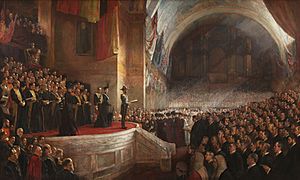
The Commonwealth of Australia came into being when the Federal Constitution was proclaimed by the Governor-General, Lord Hopetoun, on 1 January 1901. From that point a system of federalism in Australia came into operation, entailing the establishment of an entirely new national government (the Commonwealth government) and an ongoing division of powers between that government and the States. The first Federal elections were held in March 1901 and resulted in a narrow plurality for the Protectionist Party over the Free Trade Party with the Australian Labor Party (ALP) polling third. Labor declared it would offer support to the party which offered concessions and Edmund Barton's Protectionists formed a government, with Alfred Deakin as Attorney-General.

Barton promised to "create a high court, ...and an efficient federal public service... He proposed to extend conciliation and arbitration, create a uniform railway gauge between the eastern capitals, to introduce female federal franchise, to establish a...system of old age pensions." He also promised to introduce legislation to safeguard "White Australia" from any influx of Asian or Pacific Island labour.
The Labor Party (the spelling "Labour" was dropped in 1912) had been established in the 1890s, after the failure of the Maritime and Shearer's strikes. Its strength was in the Australian Trade Union movement "which grew from a membership of just under 100,000 in 1901 to more than half a million in 1914." The platform of the ALP was democratic socialist. As noted by the historian Ross McMullin, "In the national sphere Labor had taken the Protectionists as far in the direction of progressive legislation as possible." In New South Wales, Frank McDonnell dominated the agitation for the early closing of shops, which was achieved with the passage of the Factories and Shops Act of 1900, while also securing the extension of the grammar school scholarship system. In Western Australia, Forrest introduced a conciliation and arbitration bill in 1900 which brought trade unions into the state's social fabric for the first time. In addition, WA Labor scored another victory with the passage of legislation which extended workers' compensation. Under the premierships of Storey and Dooley in New South Wales, various reforms were carried out such as the establishment of the Rural Bank and the elimination of high school fees.
The Labor Party's rising support at elections, together with its formation of federal government in 1904 under Chris Watson, and again in 1908, helped to unify competing conservative, free market and liberal anti-socialists into the Commonwealth Liberal Party in 1909. Although this party dissolved in 1916, a successor to its version of "liberalism" in Australia which in some respects comprises an alliance of Millsian liberals and Burkian conservatives united in support for individualism and opposition to socialism can be found in the modern Liberal Party. To represent rural interests, the Country Party (today's National Party) was founded in 1913 in Western Australia, and nationally in 1920, from a number of state-based farmer's parties.
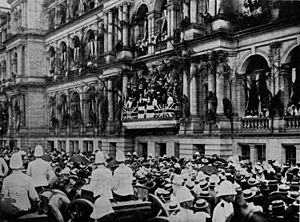
The Immigration Restriction Act 1901 was one of the first laws passed by the new Australian parliament. This centrepiece of the 'White Australia Policy' aimed to restrict immigration from Asia (especially China), where the population was vastly greater and the standard of living vastly lower and was similar to measures taken in other settler societies such as the United States, Canada and New Zealand. It found strong support in the national parliament, arguments ranging from economic protection to simple racism. The law permitted a dictation test in any European language to be used to in effect exclude non-"white" immigrants. While the law allowed for the use of any European language, the English version was standardised and became known as the "Stewart" test after the Federal MP Stewart Parnaby who originally penned the exam. The Labor Party wanted to protect "white" jobs and pushed for clearer restrictions. A few politicians spoke of the need to avoid hysterical treatment of the question. MP Bruce Smith said he had "no desire to see low-class Indians, Chinamen or Japanese...swarming into this country... But there is obligation...not (to) unnecessarily offend the educated classes of those nations". Donald Cameron, a member from Tasmania, expressed a rare note of dissension in the parliament, saying that no race on earth had been "treated in a more shameful manner than have the Chinese...". Outside parliament, Australia's first Catholic cardinal, Patrick Francis Moran was politically active and denounced anti-Chinese legislation as "unchristian". The popular press mocked the cardinal's position and the small European population of Australia generally supported the legislation and remained fearful of being overwhelmed by an influx of non-British migrants from the vastly different cultures of the highly populated empires to Australia's north.
The law passed both houses of Parliament and remained a central feature of Australia's immigration laws until abandoned in the 1950s. In the 1930s, the Lyons government unsuccessfully attempted to exclude Egon Erwin Kisch, a German Czechoslovakian communist author from entering Australia, by means of a 'dictation test' in Scottish Gaelic. The High Court of Australia ruled that Scottish Gaelic was not a European language within the meaning of the Immigration Act (1901–25). Concerns emerged that the law could be used for such political purposes.
Before 1901, units of soldiers from all six Australian colonies had been active as part of British forces in the Boer War. When the British government asked for more troops from Australia in early 1902, the Australian government obliged with a national contingent. Some 16,500 men had volunteered for service by the war's end in June 1902. But Australians soon felt vulnerable closer to home. The Anglo-Japanese Alliance of 1902 "allowed the Royal Navy to withdraw its capital ships from the Pacific by 1907. Australians saw themselves in time of war a lonely, sparsely populated outpost." The impressive visit of the US Navy's Great White Fleet in 1908 emphasised to the government the value of an Australian navy. The Defence Act of 1909 reinforced the importance of Australian defence, and in February 1910, Lord Kitchener provided further advice on a defence scheme based on conscription. By 1913, the battlecruiser Australia led the fledgling Royal Australian Navy. Historian Bill Gammage estimates that on the eve of war, Australia had 200,000 men "under arms of some sort".
Historian Humphrey McQueen has it that working and living conditions for Australia's working classes in the early 20th century were of "frugal comfort." While the establishment of the Court of Conciliation and Arbitration for industrial disputes was divisive, it was an acknowledgement of the need to set Industrial awards, where all wage earners in one industry enjoyed the same conditions of employment and wages. The Harvester Judgment of 1907 recognised the concept of a basic wage and in 1908 the Federal government also began an old age pension scheme. Together with the White Australia Policy and pioneering social policy, these developments have since been dubbed the Australian settlement. As a result of them, the new Commonwealth gained recognition as a laboratory for social experimentation and positive liberalism.
Catastrophic droughts plagued some regions in the late 1890s and early 20th century and together with a growing rabbit plague, created great hardship in the rural area of Australia. Despite this, a number of writers "imagined a time when Australia would outstrip Britain in wealth and importance, when its open spaces would support rolling acres of farms and factories to match those of the United States. Some estimated the future population at 100 million, 200 million or more." Amongst these was E. J. Brady, whose 1918 book Australia Unlimited described Australia's inland as ripe for development and settlement, "destined one day to pulsate with life."
With the encouragement of Queensland, in 1884, a British protectorate had been proclaimed over the southern coast of New Guinea and its adjacent islands. British New Guinea, was annexed outright in 1888. The possession was placed under the authority of the newly federated Commonwealth of Australia in 1902 and with passage of the Papua Act of 1905, British New Guinea became the Australian Territory of Papua, with formal Australian administration beginning in 1906.
First World War
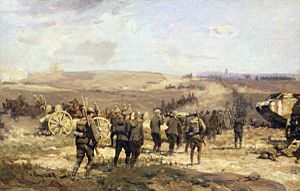
The outbreak of war in Europe in August 1914 automatically involved "all of Britain's colonies and dominions". Prime Minister Andrew Fisher probably expressed the views of most Australians when during the election campaign of late July he said "Turn your eyes to the European situation, and give the kindest feelings towards the mother country.... I sincerely hope that international arbitration will avail before Europe is convulsed in the greatest war of all time.... But should the worst happen... Australians will stand beside our own to help and defend her to the last man and the last shilling."
More than 416,000 Australian men volunteered to fight during the First World War between 1914 and 1918 from a total national population of 4.9 million. Historian Lloyd Robson estimates this as between one third and one half of the eligible male population. The Sydney Morning Herald referred to the outbreak of war as Australia's "Baptism of Fire." 8,141 men were killed in 8 months of fighting at Gallipoli, on the Turkish coast. After the Australian Imperial Forces (AIF) was withdrawn in late 1915, and enlarged to five divisions, most were moved to France to serve under British command.
Some forces remained in the Mid-East, including members of the Light Horse Regiment. Light horsemen of the 4th and 12th Regiments captured heavily fortified Beersheba from Turk forces by means of a cavalry charge at full gallop on 31 October 1917. One of the last great cavalry charges in history, the attack opened a way for the allies to outflank the Gaza-Beersheba Line and drive the Ottomans back into Palestine.
The AIF's first experience of warfare on the Western Front was also the most costly single encounter in Australian military history. In July 1916, at Fromelles, in a diversionary attack during the Battle of the Somme, the AIF suffered 5,533 killed or wounded in 24 hours. Sixteen months later, the five Australian divisions became the Australian Corps, first under the command of General Birdwood, and later the Australian General Sir John Monash. Two bitterly fought and divisive conscription referendums were held in Australia in 1916 and 1917. Both failed, and Australia's army remained a volunteer force.
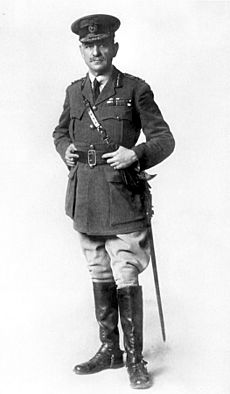
John Monash was appointed corps commander of the Australian forces in May 1918 and led some significant attacks in the final stages of the war. British Field Marshal Montgomery later called him "the best general on the western front in Europe". Monash made the protection of infantry a priority and sought to fully integrate all the new technologies of warfare in both the planning and execution of battles, thus he wrote that infantry should not be sacrificed needlessly to enemy bayonets and machine guns—but rather should "advance under the maximum possible protection of the maximum possible array of mechanical resources, in the form of guns, machine-guns, tanks, mortars and aeroplanes". His first operation at the relatively small Battle of Hamel demonstrated the validity of his approach and later actions before the Hindenburg Line in 1918 confirmed it. Monash was knighted in the field of battle by King George V following the 8 August advance during the Battle of Amiens. General Erich Ludendorff, the German commander, later wrote of 8 August 1918 as "the black day of the German Army... The 8th of August put the decline of [German] fighting power beyond all doubt". Amiens, fought between 8 and 11 August 1918, marked the beginning of the allied advance that culminated in the 11 November Armistice ended the war.
Over 60,000 Australians had died during the conflict and 160,000 were wounded, a high proportion of the 330,000 who had fought overseas.
While the Gallipoli campaign was a total failure militarily and 8100 Australians died, its memory was all-important. Gallipoli transformed the Australian mind and became an iconic element of the Australian identity and the founding moment of nationhood. Australia's annual holiday to remember its war dead is held on ANZAC Day, 25 April, each year, the date of the first landings at Gallipoli in 1915. The choice of date is often mystifying to non-Australians; it was after all, an allied invasion that ended in military defeat. Bill Gammage has suggested that the choice of 25 April has always meant much to Australians because at Gallipoli, "the great machines of modern war were few enough to allow ordinary citizens to show what they could do." In France, between 1916 and 1918, "where almost seven times as many (Australians) died,... the guns showed cruelly, how little individuals mattered."
In 1919, Prime Minister Billy Hughes and former Prime Minister Joseph Cook took Australia's seat at the Versailles peace conference. Hughes' signing of the Treaty of Versailles was the first time Australia had signed an international treaty. Hughes demanded heavy reparations from Germany and frequently clashed with US President Woodrow Wilson. At one point Hughes declared: "I speak for 60,000 [Australian] dead". He went on to ask of Wilson; "How many do you speak for?"
Hughes demanded that Australia have independent representation within the newly formed League of Nations and was the most prominent opponent of the inclusion of the Japanese racial equality proposal, which as a result of lobbying by him and others was not included in the final Treaty, deeply offending Japan. Hughes was concerned by the rise of Japan. Within months of the declaration of the European War in 1914; Japan, Australia and New Zealand seized all German possessions in the South West Pacific. Though Japan occupied German possessions with the blessings of the British, Hughes was alarmed by this policy. In 1919 at the Peace Conference the Dominion leaders argued their case to keep their occupied German possessions and these territories were given as "Class C Mandates" to the respective Dominions. Japan obtained control over the South Pacific Mandate, north of the equator. German New Guinea, the Bismarck Archipelago and Nauru were assigned to Australia as League of Nations Mandates: in the category of territories "formerly governed [by the Central Powers] and which are inhabited by peoples not yet able to stand by themselves under the strenuous conditions of the modern world". Thus, the Territory of New Guinea came under Australian administration.
Inter-war years
1920s: men, money and markets
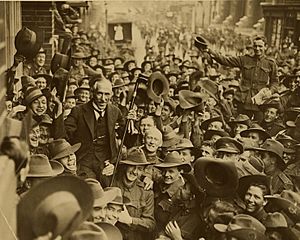
After the war, Prime Minister Billy Hughes led a new conservative force, the Nationalist Party, formed from the old Liberal party and breakaway elements of Labor (of which he was the most prominent), after the deep and bitter split over Conscription. An estimated 12,000 Australians died as a result of the Spanish flu pandemic of 1919, almost certainly brought home by returning soldiers.
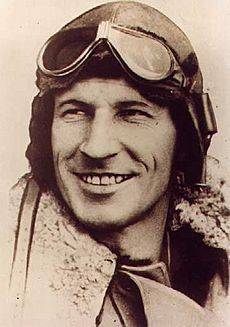

The success of the Bolshevik Revolution in Russia posed a threat in the eyes of many Australians, although to a small group of socialists, it was an inspiration. The Communist Party of Australia was formed in 1920 and, though remaining electorally insignificant, it obtained some influence in the trade union movement and was banned during World War II for its support for the Hitler-Stalin Pact and the Menzies Government unsuccessfully tried to ban it again during the Korean War. Despite splits, the party remained active until its dissolution at the end of the Cold War.
The Country Party (today's National Party) formed in 1920 to promulgate its version of agrarianism, which it called "Countrymindedness". The goal was to enhance the status of the graziers (operators of big sheep ranches) and small farmers, and secure subsidies for them. Enduring longer than any other major party save the Labor party, it has generally operated in Coalition with the Liberal Party (since the 1940s), becoming a major party of government in Australia—particularly in Queensland.
Other significant after-effects of the war included ongoing industrial unrest, which included the 1923 Victorian Police strike. Industrial disputes characterised the 1920s in Australia. Other major strikes occurred on the waterfront, in the coalmining and timber industries in the late 1920s. The union movement had established the Australian Council of Trade Unions (ACTU) in 1927 in response to the Nationalist government's efforts to change working conditions and reduce the power of the unions.
The consumerism, entertainment culture, and new technologies that characterised the 1920s in the United States were also found in Australia. Prohibition was not implemented in Australia, though anti-alcohol forces were successful in having hotels closed after 6 pm, and closed altogether in a few city suburbs.
The fledgling film industry declined through the decade, over 2 million Australians attending cinemas weekly at 1250 venues. A Royal Commission in 1927 failed to assist and the industry that had begun so brightly with the release of the world's first feature film, The Story of the Kelly Gang (1906), atrophied until its revival in the 1970s.
Stanley Bruce became Prime Minister in 1923, when members of the Nationalist Party Government voted to remove W.M. Hughes. Speaking in early 1925, Bruce summed up the priorities and optimism of many Australians, saying that "men, money and markets accurately defined the essential requirements of Australia" and that he was seeking such from Britain. The migration campaign of the 1920s, operated by the Development and Migration Commission, brought almost 300,000 Britons to Australia, although schemes to settle migrants and returned soldiers "on the land" were generally not a success. "The new irrigation areas in Western Australia and the Dawson Valley of Queensland proved disastrous"
In Australia, the costs of major investment had traditionally been met by state and Federal governments and heavy borrowing from overseas was made by the governments in the 1920s. A Loan Council was set up in 1928 to co-ordinate loans, three-quarters of which came from overseas. Despite Imperial Preference, a balance of trade was not successfully achieved with Britain. "In the five years from 1924..to..1928, Australia bought 43.4% of its imports from Britain and sold 38.7% of its exports. Wheat and wool made up more than two-thirds of all Australian exports", a dangerous reliance on just two export commodities.
Australia embraced the new technologies of transport and communication. Coastal sailing ships were finally abandoned in favour of steam, and improvements in rail and motor transport heralded dramatic changes in work and leisure. In 1918 there were 50,000 cars and lorries in the whole of Australia. By 1929 there were 500,000. The stage coach company Cobb and Co, established in 1853, finally closed in 1924. In 1920, the Queensland and Northern Territory Aerial Service (to become the Australian airline Qantas) was established. The Reverend John Flynn, founded the Royal Flying Doctor Service, the world's first air ambulance in 1928. Daredevil pilot, Sir Charles Kingsford Smith pushed the new flying machines to the limit, completing a round Australia circuit in 1927 and in 1928 traversed the Pacific Ocean, via Hawaii and Fiji from the US to Australia in the aircraft Southern Cross. He went on to global fame and a series of aviation records before vanishing on a night flight to Singapore in 1935.
Dominion status
Australia achieved independent Sovereign Nation status after World War I, under the Statute of Westminster. This formalised the Balfour Declaration of 1926, a report resulting from the 1926 Imperial Conference of British Empire leaders in London, which defined Dominions of the British empire in the following way: "They are autonomous Communities within the British Empire, equal in status, in no way subordinate one to another in any aspect of their domestic or external affairs, though united by a common allegiance to the Crown, and freely associated as members of the British Commonwealth of Nations."
However, Australia did not ratify the Statute of Westminster until 1942. According to historian Frank Crowley, this was because Australians had little interest in redefining their relationship with Britain until the crisis of World War II.
The Australia Act 1986 removed any remaining links between the British Parliament and the Australian states.
From 1 February 1927 until 12 June 1931, the Northern Territory was divided up as North Australia and Central Australia at latitude 20°S. New South Wales has had one further territory surrendered, namely Jervis Bay Territory comprising 6,677 hectares, in 1915. The external territories were added: Norfolk Island (1914); Ashmore Island, Cartier Islands (1931); the Australian Antarctic Territory transferred from Britain (1933); Heard Island, McDonald Islands, and Macquarie Island transferred to Australia from Britain (1947).
The Federal Capital Territory (FCT) was formed from New South Wales in 1911 to provide a location for the proposed new federal capital of Canberra (Melbourne was the seat of government from 1901 to 1927). The FCT was renamed the Australian Capital Territory (ACT) in 1938. The Northern Territory was transferred from the control of the South Australian government to the Commonwealth in 1911.
Great Depression
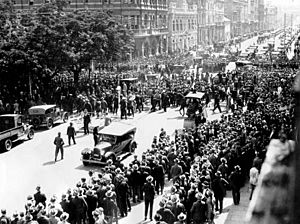
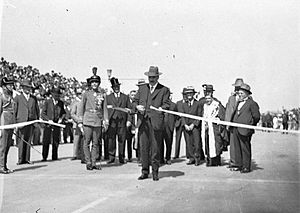
Australia was deeply affected by the Great Depression of the 1930s, particularly due to its heavy dependence on exports, especially primary products such as wool and wheat, Exposed by continuous borrowing to fund capital works in the 1920s, the Australian and state governments were "already far from secure in 1927, when most economic indicators took a turn for the worse. Australia's dependence of exports left her extraordinarily vulnerable to world market fluctuations", according to economic historian Geoff Spenceley. Debt by the state of New South Wales accounted for almost half of Australia's accumulated debt by December 1927. The situation caused alarm amongst a few politicians and economists, notably Edward Shann of the University of Western Australia, but most political, union and business leaders were reluctant to admit to serious problems. In 1926, Australian Finance magazine described loans as occurring with a "disconcerting frequency" unrivalled in the British Empire: "It may be a loan to pay off maturing loans or a loan to pay the interest on existing loans, or a loan to repay temporary loans from the bankers..." Thus, well before the Wall Street Crash of 1929, the Australian economy was already facing significant difficulties. As the economy slowed in 1927, so did manufacturing and the country slipped into recession as profits slumped and unemployment rose.
At elections held in October 1929, the Labor Party was swept into power in a landslide victory; Stanley Bruce, the former Prime Minister, lost his own seat. The new Prime Minister, James Scullin, and his largely inexperienced government were almost immediately faced with a series of crises. Hamstrung by their lack of control of the Senate, a lack of control over the banking system and divisions within their party over how best to deal with the situation, the government was forced to accept solutions that eventually split the party, as it had in 1917. Some gravitated to New South Wales Premier Lang, others to Prime Minister Scullin.
Various "plans" to resolve the crisis were suggested; Sir Otto Niemeyer, a representative of the English banks who visited in mid-1930, proposed a deflationary plan, involving cuts to government spending and wages. Treasurer Ted Theodore proposed a mildly inflationary plan, while the Labor Premier of New South Wales, Jack Lang, proposed a radical plan which repudiated overseas debt. The "Premier's Plan" finally accepted by federal and state governments in June 1931, followed the deflationary model advocated by Niemeyer and included a reduction of 20 per cent in government spending, a reduction in bank interest rates and an increase in taxation. In March 1931, Lang announced that interest due in London would not be paid and the Federal government stepped in to meet the debt. In May, the Government Savings Bank of New South Wales was forced to close. The Melbourne Premiers' Conference agreed to cut wages and pensions as part of a severe deflationary policy but Lang renounced the plan. The grand opening of the Sydney Harbour Bridge in 1932 provided little respite to the growing crisis straining the young federation. With multimillion-pound debts mounting, public demonstrations and move and counter-move by Lang and then Scullin, then Lyons federal governments, the Governor of New South Wales, Philip Game, had been examining Lang's instruction not to pay money into the Federal Treasury. Game judged it was illegal. Lang refused to withdraw his order and, on 13 May, he was dismissed by Governor Game. At June elections, Lang Labor's seats collapsed.
May 1931 had seen the creation of a new conservative political force, the United Australia Party formed by breakaway members of the Labor Party combining with the Nationalist Party. At Federal elections in December 1931, the United Australia Party, led by former Labor member Joseph Lyons, easily won office. They remained in power until September 1940. The Lyons government has often been credited with steering recovery from the depression, although just how much of this was owed to their policies remains contentious. Stuart Macintyre also points out that although Australian GDP grew from £386.9 million to £485.9 million between 1931–32 and 1938–39, real domestic product per head of population was still "but a few shillings greater in 1938–39 (£70.12), than it had been in 1920–21 (£70.04).

Australia recovered relatively quickly from the financial downturn of 1929–1930, with recovery beginning around 1932. The Prime Minister, Joseph Lyons, favoured the tough economic measures of the Premiers' Plan, pursued an orthodox fiscal policy and refused to accept the proposals of the Premier of New South Wales, Jack Lang, to default on overseas debt repayments. According to author Anne Henderson of the Sydney Institute, Lyons held a steadfast belief in "the need to balance budgets, lower costs to business and restore confidence" and the Lyons period gave Australia "stability and eventual growth" between the drama of the Depression and the outbreak of the Second World War. A lowering of wages was enforced and industry tariff protections maintained, which together with cheaper raw materials during the 1930s saw a shift from agriculture to manufacturing as the chief employer of the Australian economy—a shift which was consolidated by increased investment by the commonwealth government into defence and armaments manufacture. Lyons saw restoration of Australia's exports as the key to economic recovery.
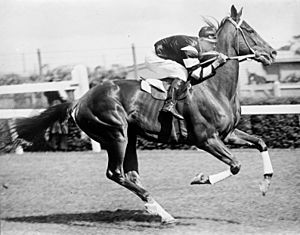
There is debate over the extent reached by unemployment in Australia, often cited as peaking at 29 per cent in 1932. "Trade Union figures are the most often quoted, but the people who were there...regard the figures as wildly understating the extent of unemployment" wrote historian Wendy Lowenstein in her collection of oral histories of the Depression. However, David Potts argues that "over the last thirty years ...historians of the period have either uncritically accepted that figure (29% in the peak year 1932) including rounding it up to 'a third,' or they have passionately argued that a third is far too low." Potts suggests a peak national figure of 25 per cent unemployed.
However, there seems little doubt that there was great variation in levels of unemployment. Statistics collected by historian Peter Spearritt show 17.8 per cent of men and 7.9 per cent of women unemployed in 1933 in the comfortable Sydney suburb of Woollahra. In the working class suburb of Paddington, 41.3 per cent of men and 20.7 per cent of women were listed as unemployed. Geoffrey Spenceley argues that apart from variation between men and women, unemployment was also much higher in some industries, such as the building and construction industry, and comparatively low in the public administrative and professional sectors. In country areas, worst hit were small farmers in the wheat belts as far afield as north-east Victoria and Western Australia, who saw more and more of their income absorbed by interest payments.
Extraordinary sporting successes did something to alleviate the spirits of Australians during the economic downturn. In a Sheffield Shield cricket match at the Sydney Cricket Ground in 1930, Don Bradman, a young New South Welshman of just 21 years of age wrote his name into the record books by smashing the previous highest batting score in first-class cricket with 452 runs not out in just 415 minutes. The rising star's world beating cricketing exploits were to provide Australians with much needed joy through the emerging Great Depression and post-World War II recovery. Between 1929 and 1931 the racehorse Phar Lap dominated Australia's racing industry, at one stage winning fourteen races in a row. Famous victories included the 1930 Melbourne Cup, following an assassination attempt and carrying 9 stone 12 pounds weight. Phar Lap sailed for the United States in 1931, going on to win North America's richest race, the Agua Caliente Handicap in 1932. Soon after, on the cusp of US success, Phar Lap developed suspicious symptoms and died. Theories swirled that the champion race horse had been poisoned and a devoted Australian public went into shock. The 1938 British Empire Games were held in Sydney from 5–12 February, timed to coincide with Sydney's sesqui-centenary (150 years since the foundation of British settlement in Australia).
Second World War
Defence policy in the 1930s
Until the late 1930s, defence was not a significant issue for Australians. At the 1937 elections, both political parties advocated increased defence spending, in the context of increased Japanese aggression in China and Germany's aggression in Europe. There was a difference in opinion over how the defence spending should be allocated however. The United Australia Party government emphasised co-operation with Britain in "a policy of imperial defence." The lynchpin of this was the British naval base at Singapore and the Royal Navy battle fleet "which, it was hoped, would use it in time of need." Defence spending in the inter-war years reflected this priority. In the period 1921–1936 totalled £40 million on the Royal Australian Navy, £20 million on the Australian Army and £6 million on the Royal Australian Air Force (established in 1921, the "youngest" of the three services). In 1939, the Navy, which included two heavy cruisers and four light cruisers, was the service best equipped for war.
Fearing Japanese intentions in the Pacific, Menzies established independent embassies in Tokyo and Washington to receive independent advice about developments. Gavin Long argues that the Labor opposition urged greater national self-reliance through a buildup of manufacturing and more emphasis on the Army and RAAF, as Chief of the General Staff, John Lavarack also advocated. In November 1936, Labor leader John Curtin said "The dependence of Australia upon the competence, let alone the readiness, of British statesmen to send forces to our aid is too dangerous a hazard upon which to found Australia's defence policy." According to John Robertson, "some British leaders had also realised that their country could not fight Japan and Germany at the same time." But "this was never discussed candidly at...meeting(s) of Australian and British defence planners", such as the 1937 Imperial Conference.
By September 1939 the Australian Army numbered 3,000 regulars. A recruiting campaign in late 1938, led by Major-General Thomas Blamey increased the reserve militia to almost 80,000. The first division raised for war was designated the 6th Division, of the 2nd AIF, there being 5 Militia Divisions on paper and a 1st AIF in the First World War.
War
On 3 September 1939, the Prime Minister, Robert Menzies, made a national radio broadcast: "My fellow Australians. It is my melancholy duty to inform you, officially, that, in consequence of the persistence by Germany in her invasion of Poland, Great Britain has declared war upon her, and that, as a result, Australia is also at war."
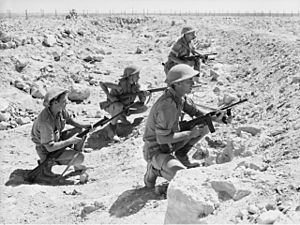
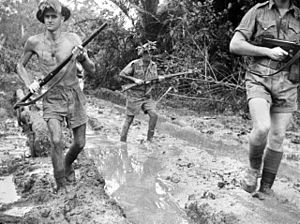
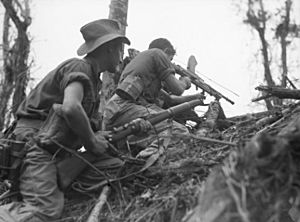
Thus began Australia's involvement in the six-year global conflict. Australians were to fight in an extraordinary variety of locations, from withstanding the advance of Hitler's Panzers in the Siege of Tobruk; to turning back the advance of the Imperial Japanese Army in the New Guinea Campaign. From bomber missions over Europe and Mediterranean naval engagements, to facing Japanese mini-sub raids on Sydney Harbour and devastating air raids on the city of Darwin.
The recruitment of a volunteer military force for service at home and abroad was announced, the 2nd Australian Imperial Force and a citizen militia organised for local defence. Troubled by Britain's failure to increase defences at Singapore, Menzies was cautious in committing troops to Europe. By the end of June 1940, France, Norway, Denmark and the Low Countries had fallen to Nazi Germany. Britain stood alone with its dominions. Menzies called for "all-out war", increasing federal powers and introducing conscription. Menzies' minority government came to rely on just two independents after the 1940 election
In January 1941, Menzies flew to Britain to discuss the weakness of Singapore's defences. Arriving in London during The Blitz, Menzies was invited into Winston Churchill's British War Cabinet for the duration of his visit. Returning to Australia, with the threat of Japan imminent and with the Australian army suffering badly in the Greek and Crete campaigns, Menzies re-approached the Labor Party to form a War Cabinet. Unable to secure their support, and with an unworkable parliamentary majority, Menzies resigned as Prime Minister. The Coalition held office for another month, before the independents switched allegiance and John Curtin was sworn in as Prime Minister. Eight weeks later, Japan attacked Pearl Harbor.
From 1940 to 1941, Australian forces played prominent roles in the fighting in the Mediterranean theatre, including Operation Compass, the Siege of Tobruk, the Greek campaign, the Battle of Crete, the Syria–Lebanon Campaign and the Second Battle of El Alamein.
A garrison of around 14,000 Australian soldiers, commanded by Lieutenant General Leslie Morshead was besieged in Tobruk, Libya by the German-Italian army of General Erwin Rommel between April and August 1941. The Nazi propagandist Lord Haw Haw derided the defenders as 'rats', a term the soldiers adopted as an ironic compliment: "The Rats of Tobruk". Vital in the defence of Egypt and the Suez Canal, the Siege saw the advance of the German army halted for the first time and provided a morale boost for the British Commonwealth, which was then standing alone against Hitler.
The war came closer to home when HMAS Sydney was lost with all hands in battle with the German raider Kormoran in November 1941.
With most of Australia's best forces committed to fight against Hitler in the Middle East, Japan attacked Pearl Harbor, the US naval base in Hawaii, on 8 December 1941 (eastern Australia time). The British battleship HMS Prince of Wales and battlecruiser HMS Repulse sent to defend Singapore were sunk soon afterwards. Australia was ill prepared for an attack, lacking armaments, modern fighter aircraft, heavy bombers, and aircraft carriers. While demanding reinforcements from Churchill, on 27 December 1941 Curtin published an historic announcement: "The Australian Government... regards the Pacific struggle as primarily one in which the United States and Australia must have the fullest say in the direction of the democracies' fighting plan. Without inhibitions of any kind, I make it clear that Australia looks to America, free of any pangs as to our traditional links or kinship with the United Kingdom."
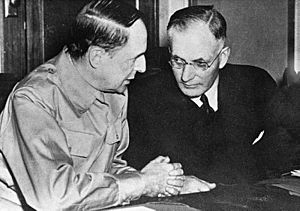
British Malaya quickly collapsed, shocking the Australian nation. British, Indian and Australian troops made a disorganised last stand at Singapore, before surrendering on 15 February 1942. Around 15,000 Australian soldiers became prisoners of war. Curtin predicted that the "battle for Australia" would now follow. On 19 February, Darwin suffered a devastating air raid, the first time the Australian mainland had ever been attacked by enemy forces. Over the following 19 months, Australia was attacked from the air almost 100 times.
Two battle-hardened Australian divisions were already steaming from the Middle East for Singapore. Churchill wanted them diverted to Burma, but Curtin refused, and anxiously awaited their return to Australia. US President Franklin D. Roosevelt ordered his commander in the Philippines, General Douglas MacArthur, to formulate a Pacific defence plan with Australia in March 1942. Curtin agreed to place Australian forces under the command of General MacArthur, who became "Supreme Commander of the South West Pacific". Curtin had thus presided over a fundamental shift in Australia's foreign policy. MacArthur moved his headquarters to Melbourne in March 1942 and American troops began massing in Australia. In late May 1942, Japanese midget submarines sank an accommodation vessel in a daring raid on Sydney Harbour. On 8 June 1942, two Japanese submarines briefly shelled Sydney's eastern suburbs and the city of Newcastle.
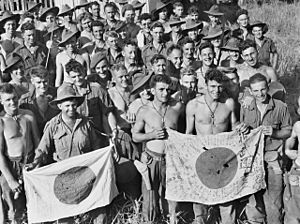
In an effort to isolate Australia, the Japanese planned a seaborne invasion of Port Moresby, in the Australian Territory of New Guinea. In May 1942, the US Navy engaged the Japanese in the Battle of the Coral Sea and halted the attack. The Battle of Midway in June effectively defeated the Japanese navy and the Japanese army launched a land assault on Moresby from the north. Between July and November 1942, Australian forces repulsed Japanese attempts on the city by way of the Kokoda Track, in the highlands of New Guinea. The Battle of Milne Bay in August 1942 was the first Allied defeat of Japanese land forces.
Meanwhile, in North Africa, the Axis Powers had driven Allies back into Egypt. A turning point came between July and November 1942, when Australia's 9th Division played a crucial role in some of the heaviest fighting of the First and Second Battle of El Alamein, which turned the North Africa Campaign in favour of the Allies.
The Battle of Buna–Gona, between November 1942 and January 1943, set the tone for the bitter final stages of the New Guinea campaign, which persisted into 1945. The offensives in Papua and New Guinea of 1943–44 were the single largest series of connected operations ever mounted by the Australian armed forces. On 14 May 1943, the Australian Hospital Ship Centaur, though clearly marked as a medical vessel, was sunk by Japanese raiders off the Queensland coast, killing 268, including all but one of the nursing staff, further enraging popular opinion against Japan.
Australian prisoners of war were at this time suffering severe ill-treatment in the Pacific Theatre. In 1943, 2,815 Australian Pows died constructing Japan's Burma-Thailand Railway In 1944, the Japanese inflicted the Sandakan Death March on 2,000 Australian and British prisoners of war—only 6 survived. This was the single worst war crime perpetrated against Australians in war.
MacArthur largely excluded Australian forces from the main push north into the Philippines and Japan. It was left to Australia to lead amphibious assaults against Japanese bases in Borneo. Curtin suffered from ill health from the strains of office and died weeks before the war ended, replaced by Ben Chifley.
Of Australia's wartime population of seven million, almost one million men and women served in a branch of the services during the six years of warfare. By war's end, gross enlistments totalled 727,200 men and women in the Australian Army (of whom 557,800 served overseas), 216,900 in the RAAF and 48,900 in the RAN. Over 39,700 were killed or died as prisoners-of-war, about 8,000 of whom died as prisoners of the Japanese.
Australian home front
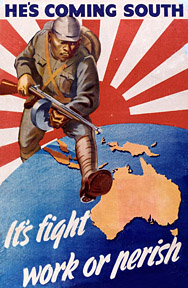
While the Australian civilian population suffered less at the hands of the Axis powers than did other Allied nations in Asia and Europe, Australia nevertheless came under direct attack by Japanese naval forces and aerial bombardments, particularly through 1942 and 1943, resulting in hundreds of fatalities and fuelling fear of Japanese invasion. Axis naval activity in Australian waters also brought the war close to home for Australians. Austerity measures, rationing and labour controls measures were all implemented to assist the war effort.
The Australian economy was markedly affected by World War II. Expenditure on war reached 37 per cent of GDP by 1943–44, compared to 4 per cent expenditure in 1939–1940. Total war expenditure was £2,949 million between 1939 and 1945.
Although the peak of army enlistments occurred in June–July 1940, when over 70,000 enlisted, it was the Curtin Labor Government, formed in October 1941, that was largely responsible for "a complete revision of the whole Australian economic, domestic and industrial life." Rationing of fuel, clothing and some food was introduced, (although less severely than in Britain) Christmas holidays curtailed, "brown outs" introduced and some public transport reduced. From December 1941, the Government evacuated all women and children from Darwin and northern Australia, and over 10,000 refugees arrived from South East Asia as Japan advanced. In January 1942, the Manpower Directorate was set up "to ensure the organisation of Australians in the best possible way to meet all defence requirements." Minister for War Organisation of Industry, John Dedman introduced a degree of austerity and government control previously unknown, to such an extent that he was nicknamed "the man who killed Father Christmas."
In May 1942 uniform tax laws were introduced in Australia, as state governments relinquished their control over income taxation, "The significance of this decision was greater than any other... made throughout the war, as it added extensive powers to the Federal Government and greatly reduced the financial autonomy of the states."
Manufacturing grew significantly because of the war. "In 1939 there were only three Australian firms producing machine tools, but by 1943 there were more than one hundred doing so." From having few front line aircraft in 1939, the RAAF had become the fourth largest allied Air force by 1945. A number of aircraft were built under licence in Australia before the war's end, notably the Beaufort and Beaufighter, although the majority of aircraft were from Britain and later, the US. The Boomerang fighter, designed and built in four months of 1942, emphasised the desperate state Australia found itself in as the Japanese advanced.
Australia also created, virtually from nothing, a significant female workforce engaged in direct war production. Between 1939 and 1944 the number of women working in factories rose from 171,000 to 286,000. Dame Enid Lyons, widow of former Prime Minister Joseph Lyons, became the first woman elected to the House of Representatives in 1943, joining the Robert Menzies' new centre-right Liberal Party of Australia, formed in 1945. At the same election, Dorothy Tangney became the first woman elected to the Senate.
Post-war boom


Menzies and Liberal dominance: 1949–72
Politically, Robert Menzies and the Liberal Party of Australia dominated much of the immediate post war era, defeating the Labor government of Ben Chifley in 1949, in part over a Labor proposal to nationalise banks and following a crippling coal strike led by the Australian Communist Party. Menzies became the country's longest-serving Prime Minister and the Liberal party, in coalition with the rural based Country Party, won every federal election until 1972.
As in the United States in the early 1950s, allegations of communist influence in society saw tensions emerge in politics. Refugees from Soviet dominated Eastern Europe immigrated to Australia, while to Australia's north, Mao Zedong's Communist Party of China won the Chinese Civil War in 1949 and in June 1950, Communist North Korea invaded South Korea. The Menzies government responded to a United States led United Nations Security Council request for military aid for South Korea and diverted forces from occupied Japan to begin Australia's involvement in the Korean War. After fighting to a bitter standstill, the UN and North Korea signed a ceasefire agreement in July 1953. Australian forces had participated in such major battles as Kapyong and Maryang San. 17,000 Australians had served and casualties amounted to more than 1,500, of whom 339 were killed.
During the course of the Korean War, the Liberal Government attempted to ban the Communist Party of Australia, first by legislation in 1950 and later by referendum, in 1951. While both attempts were unsuccessful, further international events such as the defection of minor Soviet Embassy official Vladimir Petrov, added to a sense of impending threat that politically favoured Menzies' Liberal-CP government, as the Labor Party split over concerns about the influence of the Communist Party over the trade union movement. The tensions led to another bitter split and the emergence of the breakaway Democratic Labor Party (DLP). The DLP remained an influential political force, often holding the balance of power in the Senate, until 1974. Its preferences supported the Liberal and Country Party. The Labor party was led by H.V. Evatt after Chifley's death in 1951. Evatt had served as President of the United Nations General Assembly during 1948–49 and helped draft the United Nations Universal Declaration of Human Rights (1948). Evatt retired in 1960 amid signs of mental ill-health, and Arthur Calwell succeeded him as leader, with a young Gough Whitlam as his deputy.
Menzies presided over a period of sustained economic boom and the beginnings of sweeping social change—with the arrivals of rock and roll music and television in the 1950s. In 1958, Australian country music singer Slim Dusty, who would become the musical embodiment of rural Australia, had Australia's first international music chart hit with his bush ballad "Pub With No Beer", while rock and roller Johnny O'Keefe's "Wild One" became the first local recording to reach the national charts, peaking at No. 20. Before sleeping through the 1960s Australian cinema produced little of its own content in the 1950s, but British and Hollywood studios produced a string of successful epics from Australian literature, featuring home grown stars Chips Rafferty and Peter Finch.
Menzies remained a staunch supporter of links to the monarchy and Commonwealth of Nations and formalised an alliance with the United States, but also launched post-war trade with Japan, beginning a growth of Australian exports of coal, iron ore and mineral resources that would steadily climb until Japan became Australia's largest trading partner.
When Menzies retired in 1965, he was replaced as Liberal leader and Prime Minister by Harold Holt. Holt drowned while swimming at a surf beach in December 1967 and was replaced by John Gorton (1968–1971) and then by William McMahon (1971–1972).
Post-war immigration
Following World War II, the Chifley Labor government instigated a massive program of European immigration. In 1945, Minister for Immigration, Arthur Calwell wrote "If the experience of the Pacific War has taught us one thing, it surely is that seven million Australians cannot hold three million square miles of this earth's surface indefinitely." All political parties shared the view that the country must "populate or perish." Calwell stated a preference for ten British immigrants for each one from other countries; however, the numbers of British migrants fell short of what was expected, despite government assistance.
Migration brought large numbers of southern and central Europeans to Australia for the first time. A 1958 government leaflet assured readers that unskilled non-British migrants were needed for "labour on rugged projects ...work which is not generally acceptable to Australians or British workers." The Australian economy stood in sharp contrast to war-ravaged Europe, and newly arrived migrants found employment in a booming manufacturing industry and government assisted programs such as the Snowy Mountains Scheme. This hydroelectricity and irrigation complex in south-east Australia consisted of sixteen major dams and seven power stations constructed between 1949 and 1974. It remains the largest engineering project undertaken in Australia. Necessitating the employment of 100,000 people from over 30 countries, to many it denotes the birth of multicultural Australia.
Some 4.2 million immigrants arrived between 1945 and 1985, about 40 per cent of whom came from Britain and Ireland. The 1957 novel They're a Weird Mob was a popular account of an Italian migrating to Australia, although written by Australian-born author John O'Grady. The Australian population reached 10 million in 1959.
In May 1958, the Menzies Government passed the Migration Act 1958 which replaced the Immigration Restriction Act's arbitrarily applied dictation test with an entry permit system, that reflected economic and skills criteria. Further changes in the 1960s effectively ended the White Australia Policy. It legally ended in 1973.
Economic growth and suburban living

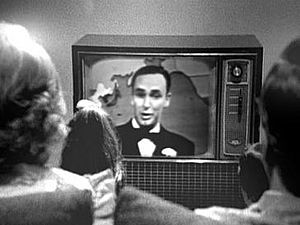
Australia enjoyed significant growth in prosperity in the 1950s and 1960s, with increases in both living standards and in leisure time. The manufacturing industry, previously playing a minor part in an economy dominated by primary production, greatly expanded. The first Holden motor car came out of General Motors-Holden's Fisherman's Bend factory in November 1948. Car ownership rapidly increased—from 130 owners in every 1,000 in 1949 to 271 owners in every 1,000 by 1961. By the early 1960s, four competitors to Holden had set up Australian factories, employing between 80,000 and 100,000 workers, "at least four-fifths of them migrants."
In the 1960s, about 60 per cent of Australian manufacturing was protected by tariffs. Pressure from business interests and the union movement ensured these remained high. Historian Geoffrey Bolton suggests that this high tariff protection of the 1960s caused some industries to "lapse into lethargy", neglecting research and development and the search for new markets. The CSIRO was expected to fulfil research and development.
Prices for wool and wheat remained high, with wool the mainstay of Australia's exports. Sheep numbers grew from 113 million in 1950 to 171 million in 1965. Wool production increased from 518,000 to 819,000 tonnes in the same period. Wheat, wool and minerals ensured a healthy balance of trade between 1950 and 1966.
The great housing boom of the post war period saw rapid growth in the suburbs of the major Australian cities. By the 1966 census, only 14 per cent lived in rural Australia, down from 31 per cent in 1933 and only 8 per cent lived on farms. Virtual full employment meant high standards of living and dramatic increases in home ownership, and by the Sixties, Australia had the most equitable spread of income in the world. By the beginning of the Sixties, an Australia-wide McNair survey estimated that 94% of homes had a fridge, 50% a telephone, 55% a television, 60% a washing machine, and 73% a vacuum cleaner. In addition, most households now acquired a car. According to one study, “In 1946, there was one car for every 14 Australians; by 1960, it was one to 3.5. The vast majority of families had access to a car.”
Car ownership flourished during the postwar period, with 1970/1971 census data estimating that 96.4 per cent of Australian households in the early Seventies owned at least one car. However, not all felt the rapid suburban growth was desirable. Distinguished Architect and designer Robin Boyd, a critic of Australia's built surroundings, described Australia as "'the constant sponge lying in the Pacific', following the fashions of overseas and lacking confidence in home-produced, original ideas." In 1956, dadaist comedian Barry Humphries performed the character of Edna Everage as a parody of a house-proud housewife of staid 1950s Melbourne suburbia (the character only later morphed into a critique of self-obsessed celebrity culture). It was the first of many of his satirical stage and screen creations based around quirky Australian characters: Sandy Stone, a morose elderly suburbanite, Barry McKenzie a naive Australian expat in London and Sir Les Patterson, a vulgar parody of a Whitlam-era politician.
Some writers defended suburban life, however. Journalist Craig Macgregor saw suburban life as a "...solution to the needs of migrants..." Hugh Stretton argued that "plenty of dreary lives are indeed lived in the suburbs... but most of them might well be worse in other surroundings." Historian Peter Cuffley has recalled life for a child in a new outer suburb of Melbourne as having a kind of joyous excitement. "Our imaginations saved us from finding life too humdrum, as did the wild freedom of being able to roam far and wide in different kinds of (neighbouring) bushland...Children in the suburbs found space in backyards, streets and lanes, playgrounds and reserves..."
In 1954, the Menzies Government formally announced the introduction of the new two-tiered TV system—a government-funded service run by the ABC, and two commercial services in Sydney and Melbourne, with the 1956 Summer Olympics in Melbourne being a major driving force behind the introduction of television to Australia. Colour TV began broadcasting in 1975.
Alliances 1950–1972

In the early 1950s, the Menzies government saw Australia as part of a "triple alliance" in concert with both the US and traditional ally Britain. At first, "the Australian leadership opted for a consistently pro-British line in diplomacy", while at the same time looking for opportunities to involve the US in South East Asia. Thus, the government committed military forces to the Korean War and the Malayan Emergency and hosted British nuclear tests after 1952. Australia was also the only Commonwealth country to offer support to the British during the Suez Crisis.
Menzies oversaw an effusive welcome to Queen Elizabeth II on the first visit to Australia by a reigning monarch, in 1954. He made the following remarks during a light-hearted speech to an American audience in New York, while on his way to attend her coronation in 1953: "We in Australia, of course, are British, if I may say so, to the boot heels...but we stand together–our people stand together –till the crack of doom."
However, as British influence declined in South East Asia, the US alliance came to have greater significance for Australian leaders and the Australian economy. British investment in Australia remained significant until the late 1970s, but trade with Britain declined through the 1950s and 1960s. In the late 1950s the Australian Army began to re-equip using US military equipment. In 1962, the US established a naval communications station at North West Cape, the first of several built over the next decade. Most significantly, in 1962, Australian Army advisors were sent to help train South Vietnamese forces, in a developing conflict in which the British had no part.
According to diplomat Alan Renouf, the dominant theme in Australia's foreign policy under Australia's Liberal – Country Party governments of the 1950s and 1960s was anti-communism. Another former diplomat, Gregory Clark, suggested that it was specifically a fear of China that drove Australian foreign policy decisions for twenty years. The ANZUS security treaty, which had been signed in 1951, had its origins in Australia's and New Zealand's fears of a rearmed Japan. Its obligations on the US, Australia and New Zealand are vague, but its influence on Australian foreign policy thinking, at times significant. The SEATO treaty, signed only three years later, clearly demonstrated Australia's position as a US ally in the emerging Cold War.
Vietnam War
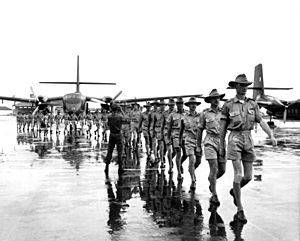
By 1965, Australia had increased the size of the Australian Army Training Team Vietnam (AATTV), and in April the Government made a sudden announcement that "after close consultation with the United States", a battalion of troops was to be sent to South Vietnam. In parliament, Menzies emphasised the argument that "our alliances made demands on us." The alliance involved was presumably, the Southeast Asia Treaty Organization (SEATO), and Australia was providing military assistance because South Vietnam, a signatory to SEATO, had apparently requested it. Documents released in 1971 indicated that the decision to commit troops was made by Australia and the US, not at the request of South Vietnam. By 1968, there were three Australian Army battalions at any one time at the 1st Australian Task Force (1ATF) base at Nui Dat in addition to the advisors of the AATTV placed throughout Vietnam, and personnel reached a peak total of almost 8,000, comprising about one third of the Army's combat capacity. Between 1962 and 1972 almost 60,000 personnel served in Vietnam, including ground troops, naval forces and air assets. The opposition Labor Party opposed military commitment to Vietnam and the national service required to support this level of commitment.
In July 1966, new Prime Minister Harold Holt expressed his government's support for the US and its role in Vietnam in particular. "I don't know where people would choose to look for the security of this country were it not for the friendship and strength of the United States." While on a visit in the same year to the US, Holt assured President Lyndon B. Johnson "...I hope there is corner of your mind and heart which takes cheer from the fact that you have an admiring friend, a staunch friend, [Australia] that will be all the way with LBJ."
The Liberal-CP Government was returned with a massive majority in elections held in December 1966, fought over national security issues including Vietnam. Arthur Calwell, who had been leader of the Labor Party since 1960, retired in favour of his deputy Gough Whitlam a few months later.
Despite Holt's sentiments and his government's electoral success in 1966, the war became unpopular in Australia, as it did in the United States. The movements to end Australia's involvement gathered strength after the Tet Offensive of early 1968 and compulsory national service (selected by ballot) became increasingly unpopular. In the 1969 elections, the government hung on despite a significant decline in popularity. Moratorium marches held across Australia in mid-1970 attracted large crowds- the Melbourne march of 100,000 being led by Labor MP Jim Cairns. As the Nixon administration proceeded with Vietnamization of the war and began the withdrawal of troops, so did the Australian Government. In November 1970 1st Australian Task Force was reduced to two battalions and in November 1971, 1ATF was withdrawn from Vietnam. The last military advisors of the AATTV were withdrawn by the Whitlam Labor Government in mid December 1972.
The Australian military presence in Vietnam had lasted 10 years, and in purely human cost, over 500 had been killed and more than 2,000 wounded. The war cost Australia $218 million between 1962 and 1972.
Modern Australia emerging 1960s
Arts and the "new nationalism"
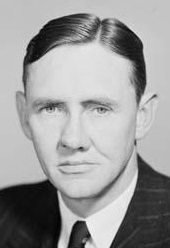
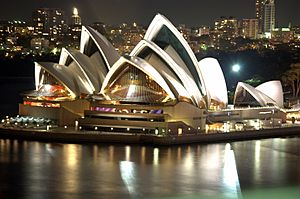
By the mid-1960s, a new nationalism was emerging. The National Trust of Australia began to be active in preserving Australia's natural, cultural and historic heritage. Australian TV saw locally-made dramas and comedies appear, and programs such as Homicide developed strong local loyalty while Skippy the Bush Kangaroo became a global phenomenon. Liberal Prime Minister John Gorton, a battle scarred former fighter pilot who described himself as "Australian to the bootheels", established the Australian Council for the Arts, the Australian Film Development Corporation and the National Film and Television Training School.
The iconic Sydney Opera House opened in 1973. In the same year, Patrick White became the first Australian to win a Nobel Prize for Literature. Australian History had begun to appear on school curricula by the 1970s. From the early 1970s, the Australian cinema began to produce the Australian New Wave of films based on uniquely Australian themes. The South Australian Film Corporation took the lead in supporting filmmaking, with successes including quintessential Australian films Sunday Too Far Away (1974), Picnic at Hanging Rock (1975), Breaker Morant (1980) and Gallipoli (1981). The national funding body, the Australian Film Commission, was established in 1975.
Significant changes also occurred to Australia's censorship laws after the new Liberal Minister for Customs and Excise, Don Chipp, was appointed in 1969. In 1968, Barry Humphries and Nicholas Garland's cartoon book featuring the larrikin character Barry McKenzie was banned. Only a few years later, the book had been made as a film, partly with the support of government funding. Barry McKenzie both celebrated and parodied Australian nationalism. Historian Richard White also argues that "while many of the plays, novels and films produced in the 1970s were intensely critical of aspects of Australian life, they were absorbed by the 'new nationalism' and applauded for their Australianness."
In 1973, businessman Ken Myer commented; "we like to think we have a distinct style of our own. We have outgrown a lot of our inadequacies.... There was a time when an interest in the arts threw doubts on one's masculinity." In 1973, historian Geoffrey Serle, in his 1973 From Deserts the Prophets Come, argued that while Australia had finally arrived at "mature nationhood," until that time that the "most important study of Australia had been found in creative treatments", rather than academic study at universities and schools.
Civil rights developments
Indigenous people
The 1960s was a key decade for indigenous rights. In 1962, the Menzies Government's Commonwealth Electoral Act provided that all Indigenous people should have the right to enrol and vote at federal elections (prior to this, indigenous people in Queensland, Western Australia and "wards of the state" in the Northern Territory had been excluded from voting unless they were ex-servicemen). In 1965, Queensland became the last state to confer state voting rights on Aboriginal people.
A 1967 Referendum called by the Holt Government saw Australians vote by a 90 per cent majority to change the Australian constitution to include all Aboriginal Australians in the national census and allow the Federal parliament to legislate on their behalf. A Council for Aboriginal Affairs was established.
Indigenous Australians began to take up representation in Australian parliaments. In 1971, the Liberal Neville Bonner was appointed to the Senate, becoming the first Aboriginal Australian in Federal Parliament. Bonner remained in the Senate until 1983. Hyacinth Tungutalum of the Country Liberal Party in the Northern Territory and Eric Deeral of the National Party of Queensland, became the first Indigenous people elected to territory and state legislatures in 1974. In 1976, Sir Douglas Nicholls was appointed Governor of South Australia, becoming the first Aboriginal Australian to hold vice-regal office in Australia. No indigenous person was elected to the House of Representatives, until West Australian Liberal Ken Wyatt, in August 2010.
Various groups and individuals were active in the pursuit of indigenous rights from the 1960s. One of the earliest Aboriginal graduates from the University of Sydney, Charles Perkins, helped organise freedom rides into parts of Australia to expose discrimination and inequality. In 1966, the Gurindji people of Wave Hill station commenced the Gurindji strike in a quest for equal pay and recognition of land rights.
One of the first acts of the Whitlam Government was to establish a Royal Commission into land rights in the Northern Territory under Justice Woodward. Legislation based on its findings was passed into law by the Fraser Government in 1976, as the Aboriginal Land Rights Act 1976.
In 1992, the High Court of Australia handed down its decision in the Mabo Case, holding that the legal doctrine of terra nullius did not apply when Australia was settled, and therefore Indigenous native title survived reception of English law. That same year, Prime Minister Paul Keating said in his Redfern Park Speech that European settlers were responsible for the difficulties Australian Aboriginal communities continued to face: 'We committed the murders. We took the children from their mothers. We practised discrimination and exclusion. It was our ignorance and our prejudice'. In 1999 Parliament passed a Motion of Reconciliation drafted by Prime Minister John Howard and Aboriginal Senator Aden Ridgeway naming mistreatment of Indigenous Australians as the most "blemished chapter in our national history". In 2008, Prime Minister Kevin Rudd issued a public apology to members of the Stolen Generations on behalf of the Australian Government.
Australia administered Papua New Guinea and Nauru for much of the 20th century. Papua and New Guinea adopted self-government in 1972 and on 15 September 1975, the Territory became the independent nation of Papua New Guinea. Australia had captured the island of Nauru from the German Empire in 1914. After Japanese occupation during World War II, it became a UN Trust Territory under Australia and remained so until achieving independence in 1968.
Women
In 1974, the Commonwealth Court of Conciliation and Arbitration granted women the full adult wage. However, resistance to women being employed in certain industries remained until well into the 1970s. Because of obstruction from elements of the Unions movement, it would take until 1975 for women to be admitted as drivers on Melbourne's trams, and Sir Reginald Ansett refused to allow women to train as pilots as late as 1979.
Australia had led the world in bringing women's suffrage rights during the late 19th century, and Edith Cowan was elected to the West Australian Legislative Assembly in 1921. Dame Enid Lyons, was the first woman to hold a Cabinet post in the 1949 ministry of Robert Menzies and finally, Rosemary Follett was elected Chief Minister of the Australian Capital Territory in 1989, becoming the first woman elected to lead a state or territory. By 2010, the people of Australia's oldest city, Sydney had female leaders occupying every major political office above them, with Clover Moore as Lord Mayor, Kristina Keneally as Premier of New South Wales, Marie Bashir as Governor of New South Wales, Julia Gillard as Prime Minister, Quentin Bryce as Governor-General of Australia and Elizabeth II as Queen of Australia.
Whitlam and Fraser
Elected in December 1972 after 23 years in opposition, Labor won office under Gough Whitlam, introducing a significant program of social change and reform and dramatically expanding the Federal budget. Within a few weeks the last military advisors in Vietnam were recalled, and national service ended. The People's Republic of China was recognised (Whitlam had visited China while Opposition Leader in 1971) and the embassy in Taiwan closed. Over the next few years, university fees were abolished and a national health care scheme established. Significant changes were made to school funding.
The Whitlam government's agenda endeared it to some Australians, but not all. Some of the state governments were openly hostile to it, and as it did not control the senate, much of its legislation was rejected or amended. The Queensland Country Party government of Joh Bjelke-Petersen had particularly bad relations with the Federal government. Even after it was re-elected at elections in May 1974, the Senate remained an obstacle to its political agenda. At the only joint sitting of parliament, in August 1974, six key pieces of legislation were passed.
In 1974, Whitlam selected John Kerr, a former member of the Labor Party and presiding Chief Justice of New South Wales to serve as Governor-General. The Whitlam Government was re-elected with a decreased majority in the lower house in the 1974 Election. In 1974–75 the government thought about borrowing US$4 billion in foreign loans. Minister Rex Connor conducted secret discussions with a loan broker from Pakistan, and the Treasurer, Jim Cairns, misled parliament over the issue. Arguing the government was incompetent following the Loans Affair, the opposition Liberal-Country Party Coalition delayed passage of the government's money bills in the Senate, until the government would promise a new election. Whitlam refused, Malcolm Fraser, leader of the Opposition insisted. The deadlock ended when the Whitlam government was dismissed by the Governor-General, John Kerr on 11 November 1975 and Fraser was installed as caretaker Prime Minister, pending an election. The "reserve powers" granted to the Governor-General by the Australian Constitution, had allowed an elected government to be dismissed without warning by a representative of the Monarch.
At elections held in late 1975, Malcolm Fraser and the Coalition were elected in a landslide victory.
The Fraser Government won two subsequent elections. Fraser maintained some of the social reforms of the Whitlam era, while seeking increased fiscal restraint. His government included the first Aboriginal federal parliamentarian, Neville Bonner, and in 1976, Parliament passed the Aboriginal Land Rights Act 1976, which, while limited to the Northern Territory, affirmed "inalienable" freehold title to some traditional lands. Fraser established the multicultural broadcaster SBS, welcomed Vietnamese boat people refugees, opposed minority white rule in Apartheid South Africa and Rhodesia and opposed Soviet expansionism. A significant program of economic reform however was not pursued and, by 1983, the Australian economy was in recession, amidst the effects of a severe drought. Fraser had promoted "states' rights" and his government refused to use Commonwealth powers to stop the construction of the Franklin Dam in Tasmania in 1982. A Liberal minister, Don Chipp had split off from the party to form a new social liberal party, the Australian Democrats in 1977 and the Franklin Dam proposal contributed to the emergence of an influential Environmental movement in Australia, with branches including the Australian Greens, a political party which later emerged from Tasmania to pursue environmentalism as well as left-wing social and economic policies.
Hawke and Keating: 1983–1996
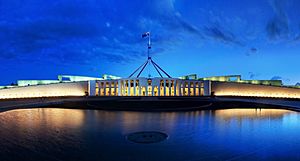
Bob Hawke, a less polarising Labor leader than Whitlam, defeated Fraser at the 1983 Election. Hawke retained office until a 1991 Labor Party spill saw him replaced by Paul Keating.
The new government stopped the Franklin Dam project via the High Court of Australia. Hawke, together with treasurer Paul Keating broke with the Keynesian economics that had traditionally been favoured by the Labor party. Instead they sought a more efficient economy and undertook micro-economic and industrial relations reform designed to increase efficiency and competitiveness. Kelly concludes that, "In the 1980s both Labor and non-Labor underwent internal philosophical revolutions to support a new set of ideas—faith in markets, deregulation, a reduced role for government, low protection and the creation of a new cooperative enterprise culture."
The Australian Bicentenary was celebrated in 1988 along with the opening of a new Parliament House in Canberra.
Hawke and Keating stressed the positive role Australia could play as an activist and independent "middle power." A supporter of the US alliance, Hawke committed Australian naval forces to the Gulf War, following the 1990 invasion of Kuwait by Iraq. After four successful elections, but amid a deteriorating Australian economy and rising unemployment, the intense rivalry between Hawke and Keating led the Labor Party to replace Hawke as leader and Paul Keating became Prime Minister in 1991.
During his time in office, Keating emphasised links to the Asia Pacific region, co-operating closely with the Indonesian President, Suharto, and campaigned to increase the role of APEC as a major forum for economic co-operation. Keating was active in indigenous affairs and the High Court of Australia's historic Mabo decision in 1992 required a legislative response to recognition of Indigenous title to land, culminating in the Native Title Act 1993 and the Land Fund Act 1994. In 1993, Keating established a Republic Advisory Committee, to examine options for Australia becoming a republic.
The Monarchy in Australia survived the republic debate which was brought to a head at the close of the 20th century, with the successor Howard Government holding a 1998 Constitutional Convention to discuss the change. A subsequent referendum to establish a republic failed to achieve the required dual majorities, with the No case triumphant winning with 54.87 per cent of the popular vote and 6–0 in the state count.
Hawke and Keating abandoned traditional Labor support for tariffs to protect industry and jobs. They moved to deregulate Australia's financial system and 'floated' the Australian dollar. After the initial failure of the Whitlam model and partial dismantling under Fraser, Hawke re-established a new, universal system of health insurance called Medicare.
Unemployment reached 11.4 per cent in 1992—the highest since the Great Depression. The Liberal-National Opposition had proposed an ambitious plan of economic reform to take to the 1993 Election, including the introduction of a Goods and Services Tax. Keating shuffled treasurers, campaigned strongly against the tax, and won the 1993 Election.
With foreign debt, interest rates and unemployment still high, and after a series of ministerial resignations, Keating lost the 1996 Election to the Liberals' John Howard.
Howard government: 1996–2007
John Howard with a Liberal–National Party coalition served as Prime Minister from 1996 until 2007, the second-longest prime ministerial term after Menzies. One of the first programs instigated by the Howard government was a nationwide gun control scheme following a mass shooting at Port Arthur. The government also introduced industrial relations reforms in 1996, and later in 2006 controversially introduced the WorkChoices legislation, which made it easier for small businesses to terminate employment. After the 1996 election, Howard and treasurer Peter Costello proposed a Goods and Services Tax (GST) which they successfully took to the electorate in 1998. In response to the High Court's decision in Wik Peoples v Queensland, the Howard Government introduced legislation which, among other things, introduced a registration test for claimants, gave the government management rights over recognised native title, and imposed stricter time limits on claims.
In 1999, Australia led a United Nations force into East Timor to help establish democracy and independence for that nation, following political violence. During this period Australia committed to a number of other peacekeeping and stabilisation operations: notably in Bougainville, including Operation Bel Isi (1998–2003); as well as Operation Helpem Fren and the Australian-led Regional Assistance Mission to Solomon Islands (RAMSI) in the early 2000s; and the 2006 East Timorese crisis.
Australia hosted the 2000 Summer Olympics in Sydney to great international acclaim. The Opening Ceremony featured a host of iconic Australian imagery and history and the flame ceremony honoured women athletes, including swimmer Dawn Fraser, with Aboriginal runner Cathy Freeman lighting the Olympic flame.
In 2004, Howard led the response to the 2004 Boxing Day tsunami, with Australia raising the most money in the least amount of time to help Australia's neighbour, Indonesia, and other countries in the Indo-Pacific Ocean.
In 2005, following the September 11 attacks, the 2002 Bali Bombings and the Benbrika Plot, the Government introduced new counter-terrorism laws which, among other things, allowed for preventative detention and control orders, prohibited incitement of terrorist acts, and prohibited reckless provision of funding to terrorists. Australia also committed troops to the Afghanistan War (with bi-partisan support) and the Iraq War (meeting with the disapproval of other political parties).
The Howard Government expanded immigration overall, but instituted often controversial tough immigration policies and laws to discourage people arriving by boat without authorisation. These policies included the Pacific Solution, which involved detaining asylum seekers in detention centres in Naru and Papua New Guinea while their refugee status was determined, as well as a policy of turning back vessels intercepted at sea. Two significant controversies involving asylum seekers were the Children Overboard affair and the Tampa Affair.
While Australia maintained traditional links to the Commonwealth and strong support for the United States alliance, trade with Asia during this period continued to increase dramatically, particularly with China. Australia enjoyed an extended period of economic growth and prosperity.
The Howard Government passed several tax cuts and embarked on a program of privatisation.
21st century
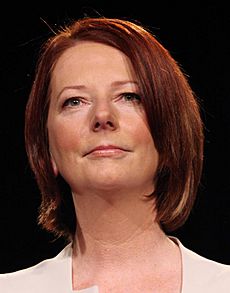
Labor Government: 2007-2013
However, Howard was defeated in 2007 and the Labor Party's Kevin Rudd defeated him and Rudd held the office until June 2010, when he was replaced as the leader of the party. Rudd used his term in office to symbolically ratify the Kyoto Protocol and led an historic parliamentary apology to the Stolen Generation (those Indigenous Australians who had been removed from their parents by the state during the early 20th century to the 1960s). The mandarin Chinese speaking former diplomat also pursued energetic foreign policy and initially sought to instigate a price on carbon, in the Australian economy to combat global warming but which he later reneged on. His prime ministership coincided with the initial phases of the Financial crisis of 2007–2010, to which his government responded quickly through a large package of economic stimulus—the management of which later proved to be controversial but effective in somewhat shielding Australia from the Great Recession but this was owed to a number of factors including the Mining Boom and Asia. The Rudd Government also finalised withdrawing troops from Iraq and focused much more on its relationship with Asia, the Government also tried to formalise an agreement to be made at the Copenhagen Climate Conference, but failed. The Government also embarked on a huge infrastructure project, which was to be fraught with trouble, the National Broadband Network (NBN), this project aims to lift average Australian internet speeds to be on par with the rest of the world, however the most major policy decision was the cancellation of the Howard Government's Pacific Solution, but as Kevin Rudd cancelled the arrangement, the number of boat arrivals swelled and the death toll rose, so in response to this, the Gillard Government created multiple different solutions, including proposing Malaysian resettlement, but eventually settling on Nauru, Manus Island and East Timor as refugee resettlement options.
The Labor Party replaced Rudd with Julia Gillard in 2010 owing to Rudd's unpopularity both among his frontbench and the public, so then Julia Gillard became the first woman prime minister in Australian history. Following the 2010 Election, Labor secured office in the first hung parliament since the 1940 election. The Gillard Government struggled on multiple policy fronts, trying to wrestle with a hung parliament. Opposition to Gillard's government following her misogyny speech intensified. Leadership rivalry continued and Kevin Rudd was reinstated as prime minister in a Labor leadership spill on 27 June 2013. At the 2013 Election, the Second Rudd Government lost office and the Liberal-National Abbott Government formed.
Liberal-National Coalition governments: (2013–2022)
The return of the Liberal-National Coalition to power after six years in opposition initially failed to restore stability to the office of prime minister. Prime Minister Tony Abbott's rival Malcolm Turnbull challenged for and won the leadership of the Liberals within Abbott's first term. After Turnbull narrowly returned the Coalition to office in 2016, Party dissatisfaction with his leadership saw him replaced by Scott Morrison in 2018.

Prime Minister Tony Abbott's Liberal-National Coalition government began implementing its policies on unauthorised maritime arrivals, including Operation Sovereign Borders, boat turnbacks, the reintroduction of temporary protection visas, and the resettlement in third countries of those found to be refugees. The new policy strained relations with Indonesia, but the number of people arriving by boat fell from 20,587 in 2013 to none in 2015. The government continued Australia's economic engagement with Asia, signing trade agreements with China, South Korea and Japan. The government also embraced the intervention against Islamic State in Iraq and Syria, joining the air campaign, sending special forces and providing training for the Iraqi army.
The government made cuts to Indigenous programs, brought the Indigenous Affairs portfolio into the Cabinet, and established the Indigenous Advisory Council.
The government's May 2014 Budget, which included measures such as the deregulation of university fees, welfare cuts and projected cuts to funding to the states for health and education, proved unpopular, with the perception that it had involved breaking a number of election promises. The government secured the passage of legislation abolishing the carbon tax (July 2014) and the mining tax (September 2014).
The Prime Minister announced a number of decisions – most notably the reintroduction of knighthoods and a knighthood for Prince Philip, Duke of Edinburgh – which had not been approved by cabinet and which were widely criticised in the media. By September 2015 the government had lost 30 Newspolls in a row and Malcolm Turnbull successfully challenged for the leadership.
- Turnbull government (2015–2018)
The new Turnbull government promised to promote a "smart, agile and innovative Australia" and "jobs and growth". The government announced a National Innovation and Science Agenda and delivered a Budget featuring cuts to company tax. However, the elections of July 2016 saw the government returned with a majority on only one and a minority in the Senate, making it more difficult to secure the passage of government legislation. Following a national postal plebiscite, the government legalised same-sex marriage in December 2017.
In foreign affairs, Australia signed a refugee exchange deal with the US in September 2016, allowing those in detention on Manus Island and Nauru to be settled in the US. There was increased tension with China because of Australia's criticism of China's policies in the South China Sea, Australia's new laws targeting foreign influence in domestic politics, and a ban, on national security grounds, on Chinese companies supplying Australia's 5G communications network. Trade with China, however, continued to grow.
In 2017, the United States, Japan, India and Australia agreed to revive the Quadrilateral Security Dialogue in order to counter Chinese ambitions in the South China Sea. Australia signed a modified Trans-Pacific Partnership trade agreement with 10 other nations in March 2018 after the US withdrew from the original agreement.
The government lost five by-elections in July 2018. When, in August, the government sought to introduce legislation for a National Energy Guarantee, including a commitment to meet Australia's emissions target under the Paris Agreement, a number of Coalition members vowed to vote against the bill. The resulting controversy further harmed the government, which had already lost more than 30 consecutive Newspolls. The parliamentary Liberal Party elected Scott Morrison as its new leader and he was sworn in as Prime Minister.
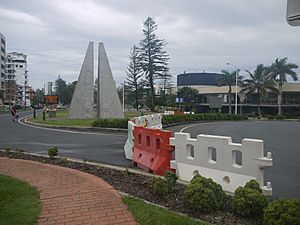
The Morrison government committed to remaining in the Paris Agreement, but promised a greater focus on reduction of energy prices. In foreign affairs the government signed the Indonesia–Australia Comprehensive Economic Partnership Agreement (IA-CEPA) in March 2019. In April, the treasurer delivered a Budget focusing on tax cuts, increased spending on roads and other infrastructure, and a forecast return to a surplus. The government was returned at the elections of May 2019 with a three-seat majority.
In 2017, a constitutional convention of 250 Aboriginal and Torres Strait Islander delegates had issued the Uluru Statement from the Heart, calling for the recognition of Indigenous sovereignty, a Makarrata (truth telling and agreement-making) Commission, constitutional recognition of Indigenous Australians and a "voice to parliament". In 2019, the government announced a process to "develop options for a model that will ensure that Aboriginal and Torres Strait Islander people are heard at all levels of government".
Within a year the government was confronted with the international COVID-19 pandemic and the subsequent recession, Australia's first in 29 years. From 1 February 2020, Australia progressively closed its borders to foreign nationals who had recently visited high-risk countries, culminating, on 20 March, in a general ban on the entry of foreign nationals. On 13 March 2020, a National Cabinet, including Australian government, state government and territory government leaders, was created to address the crisis. The national cabinet announced a series of increasingly tighter restrictions on non-essential business, travel and gatherings of people with the aim of suppressing COVID. These restrictions were progressively eased from early May, although individual states and territories intermittently reimposed restrictions in response to particular outbreaks of COVID-19.
The Australian government made provision for $267 billion in economic stimulus measures, and $16.6 billion in health measures in response to COVID-19. As a result of the COVID-19 recession, the unemployment rate rose from about 5 per cent in February 2020 to 7.5 per cent in July 2020. As the economy began to recover from the second half of 2020, the unemployment rate fell to 5.6 per cent in March 2021 and hours worked returned to pre-recession levels. As at 17 April 2021, Australia was ranked 134 out of 177 countries in the number of COVID-19 deaths per capita.
In June 2021 Australia and the United Kingdom announced that they had struck a preliminary deal on a free-trade agreement.
On 16 September 2021, the government announced that Australia, the United Kingdom and the United States had agreed to the creation of an enhanced trilateral security partnership, dubbed AUKUS. The first initiative under AUKUS would be for Australia to acquire nuclear-powered submarine technology. As a result of the agreement, Australia cancelled its 2016 contract for the diesel-electric Attack-class submarine with the French company Naval Group. China condemned the AUKUS agreement, stating it "seriously undermines regional peace and stability and intensifies the arms race". France announced it would withdraw its ambassador from Australia in protest against the lack of consultation on the security agreement and the cancellation of the $90 billion dollar contract for French submarines.
Post-pandemic: 2022 to present
Albanese government (2022– present)
On 23 May 2022, Anthony Albanese was sworn in as Australia's new prime minister. His Labor Party defeated Scott Morrison's conservative government in the election. Prime Minister Albanese formed Australia's first Labor government in almost a decade. In December 2022, the prime minister announced that a referendum for an Indigenous Voice to parliament would be held before December 2023.
On 30 January 2023, Albanese unveiled a new national cultural policy 'Revive' with $286 million in funding over four years, labelled the most significant investment in Australian culture since the Keating government. The Revive policy's centrepiece establishes 'Creative Australia', with four new bodies; a First Nations-led body, Music Australia, Writers Australia and the Centre for Arts and Entertainment Workplaces. Revive's legislation also granted protection for First Nations culture as well as funding toward a First Nations languages partnership between First Nations representatives and Australian governments and funding the establishment of a National Aboriginal Art Gallery in Alice Springs and an Aboriginal Cultural Centre in Perth. The policy also provided regulation for a revenue levy for streaming services to reinvest in locally produced cinema and television productions. Revive policy also included the first establishment of a poet laureate for Australia.
Images for kids
-
View of Sydney Cove (Aboriginal: Warrane) by Thomas Watling, 1794–1796
-
The origins of a distinctly Australian style of painting are often associated with the Heidelberg School movement, Tom Roberts' Shearing the Rams (1890) being an iconic example.
-
Built 1930 and a cultural masterpiece of Australian architecture, Brisbane City Hall was one of the most expensive buildings and the second largest construction of the Inter-war period, after the Sydney Harbour Bridge.
-
Sir Robert Menzies, founder of the Liberal Party of Australia and Prime Minister of Australia 1939–41 (UAP) and 1949–66
-
After World War II and by the 1950s, Australia had a population of 10 million, and the most populous urban centre was its oldest city, Sydney. It has retained its status as Australia's largest city ever since.
-
Gough Whitlam and US President Richard Nixon in 1973. The Whitlam Government was responsible for significant reforms, but went on to be dismissed in controversial circumstances.
-
Bob Hawke with Soviet leader Mikhail Gorbachev in 1987. Hawke went on to become the longest-serving Labor Prime Minister.
-
Australian special forces wait for extraction during the War in Afghanistan (2001–2021)
See also
 In Spanish: Historia de Australia para niños
In Spanish: Historia de Australia para niños


